江苏省盐城市亭湖区永丰初级中学牛津译林版英语七年级下Unit 3 Welcome to Sunshine Town单元知识点讲解课件(63张PPT)
文档属性
| 名称 | 江苏省盐城市亭湖区永丰初级中学牛津译林版英语七年级下Unit 3 Welcome to Sunshine Town单元知识点讲解课件(63张PPT) | 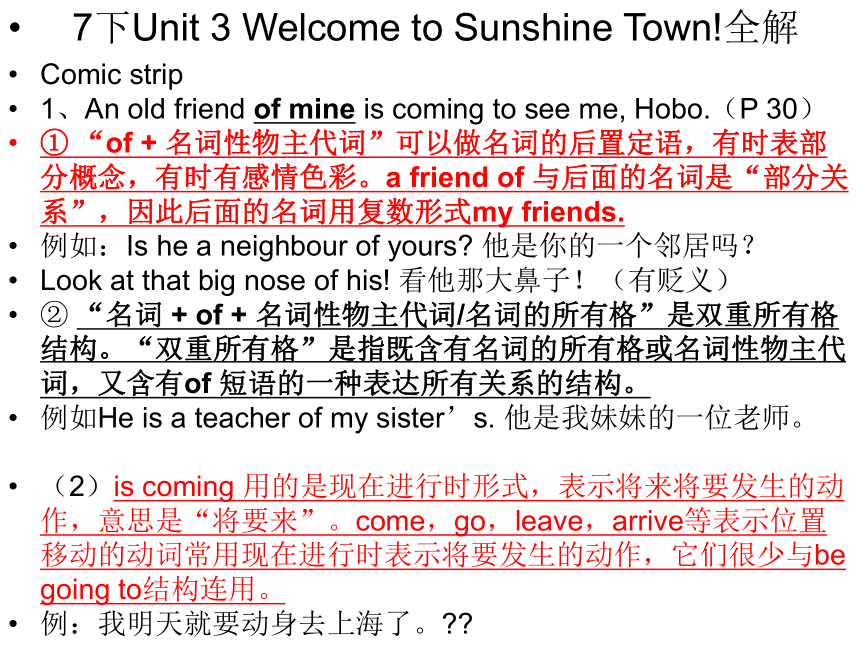 | |
| 格式 | zip | ||
| 文件大小 | 406.5KB | ||
| 资源类型 | 教案 | ||
| 版本资源 | 牛津译林版 | ||
| 科目 | 英语 | ||
| 更新时间 | 2020-02-11 00:07:16 | ||
图片预览

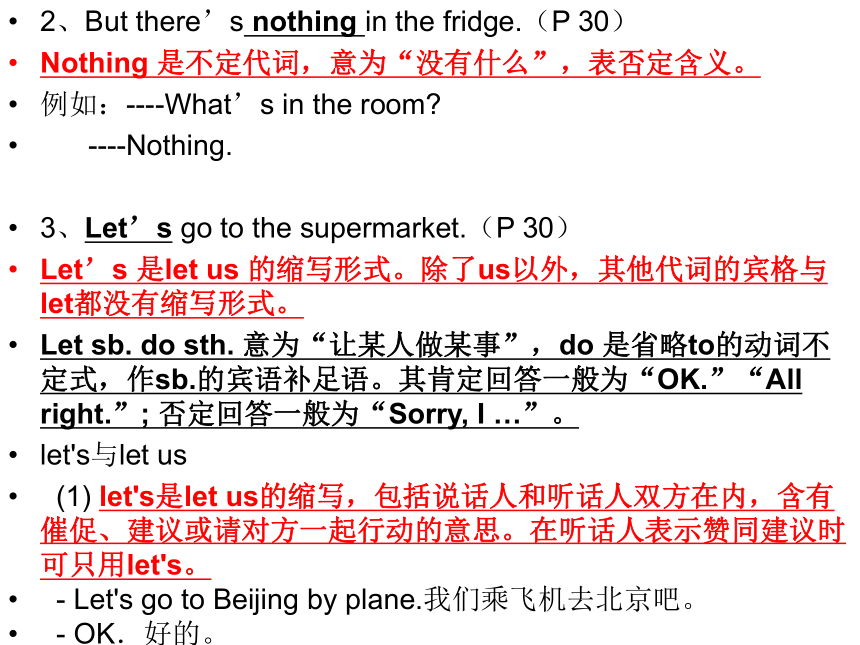

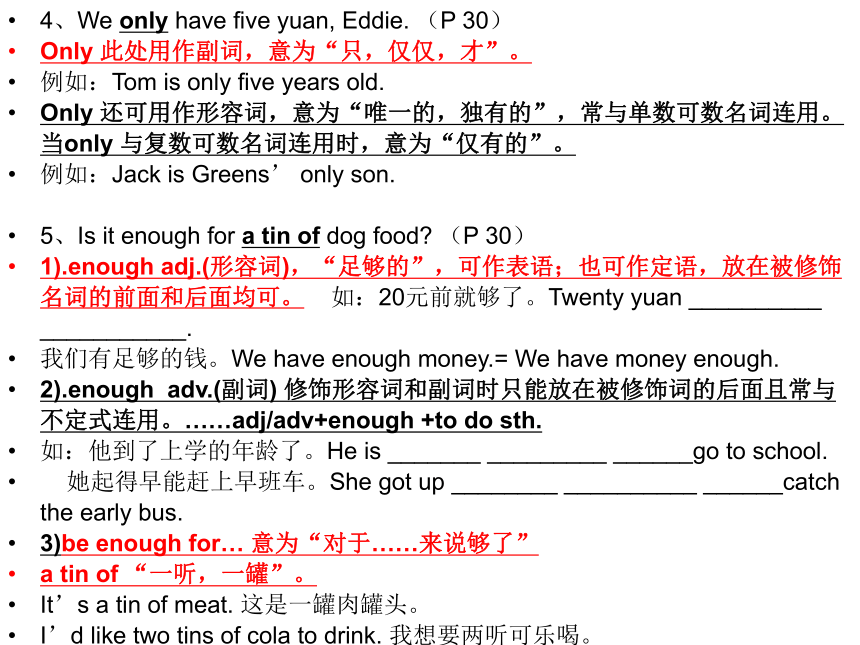
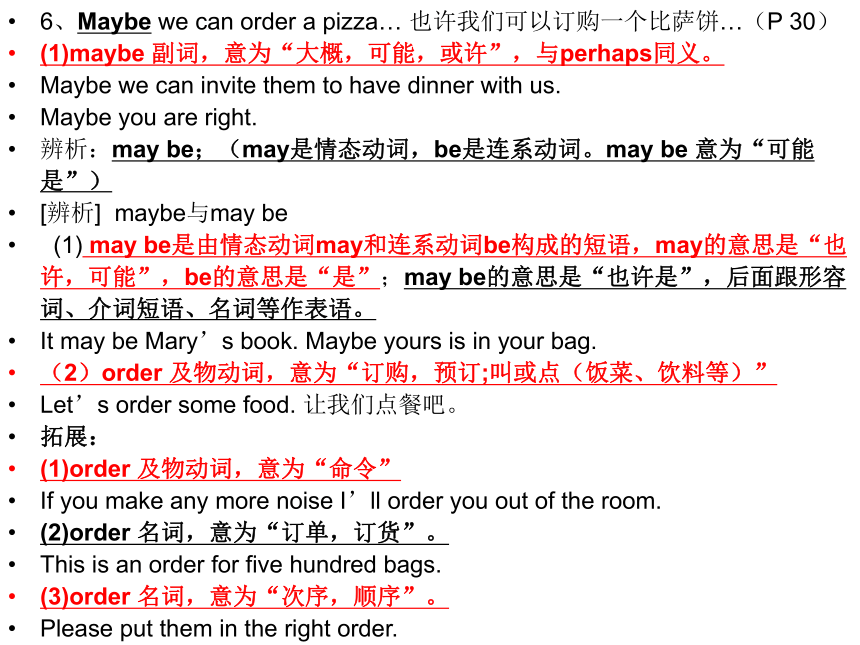
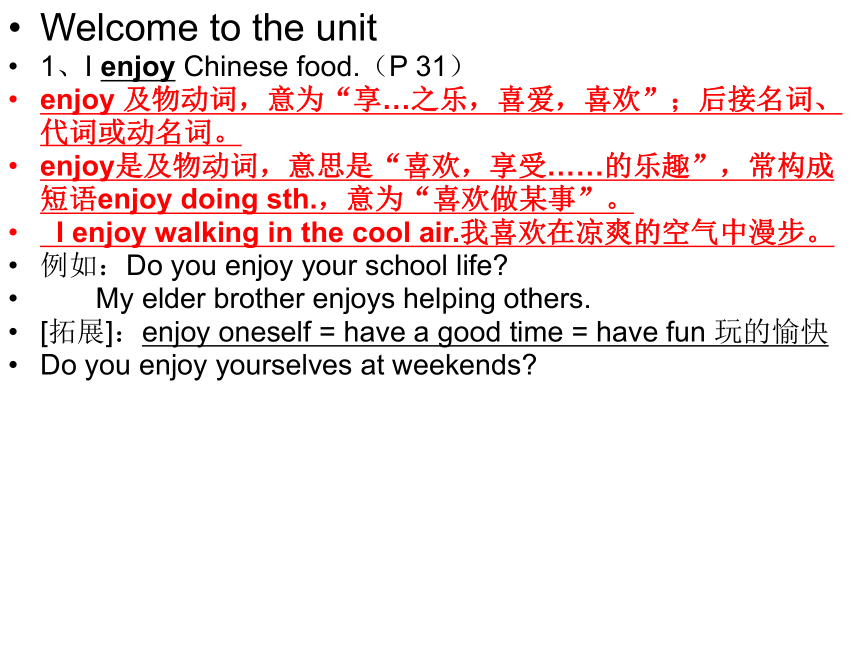
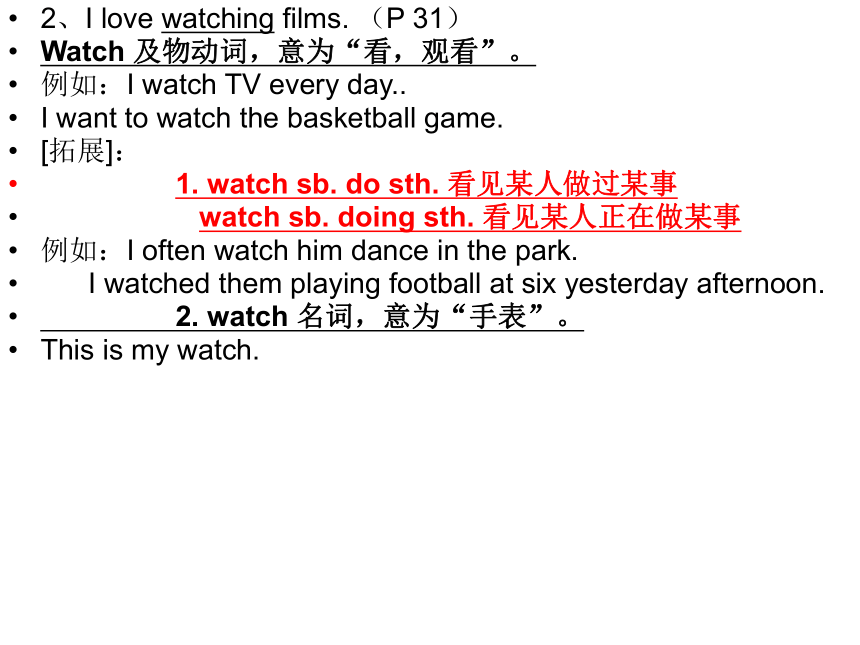
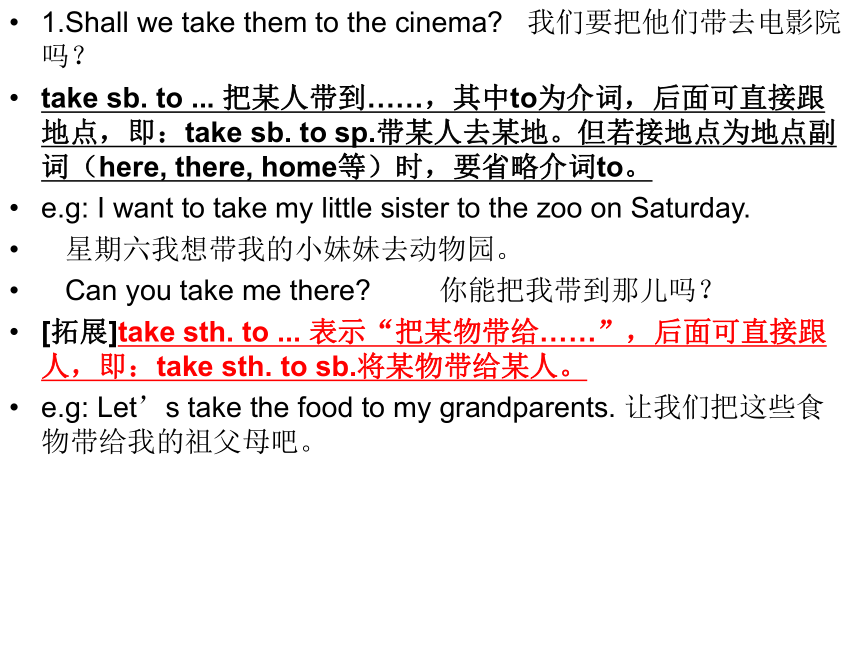
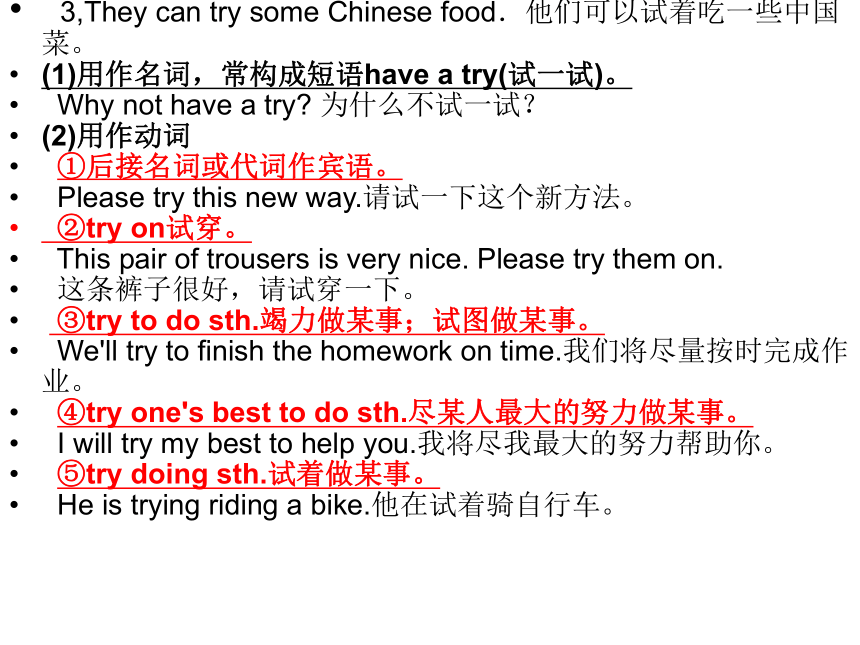
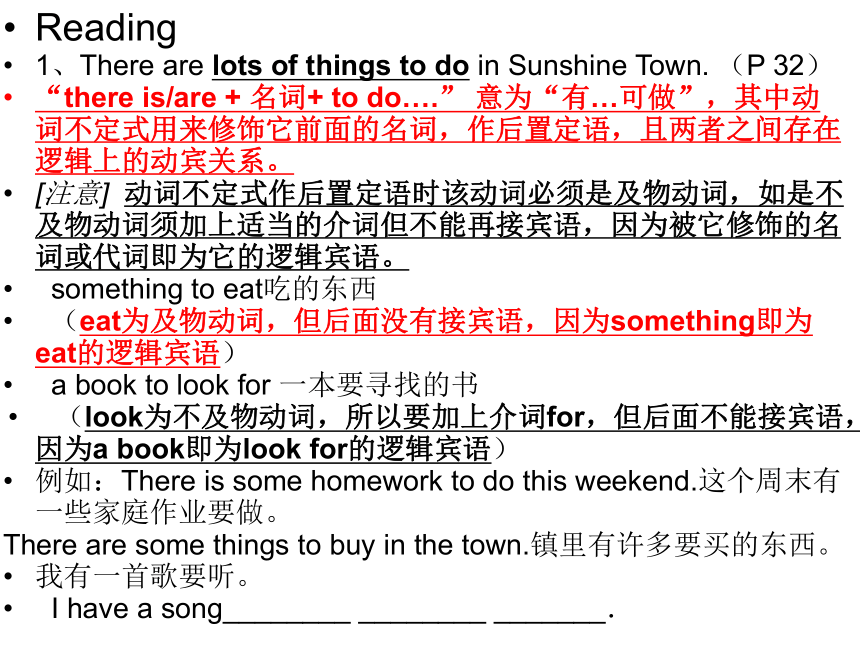
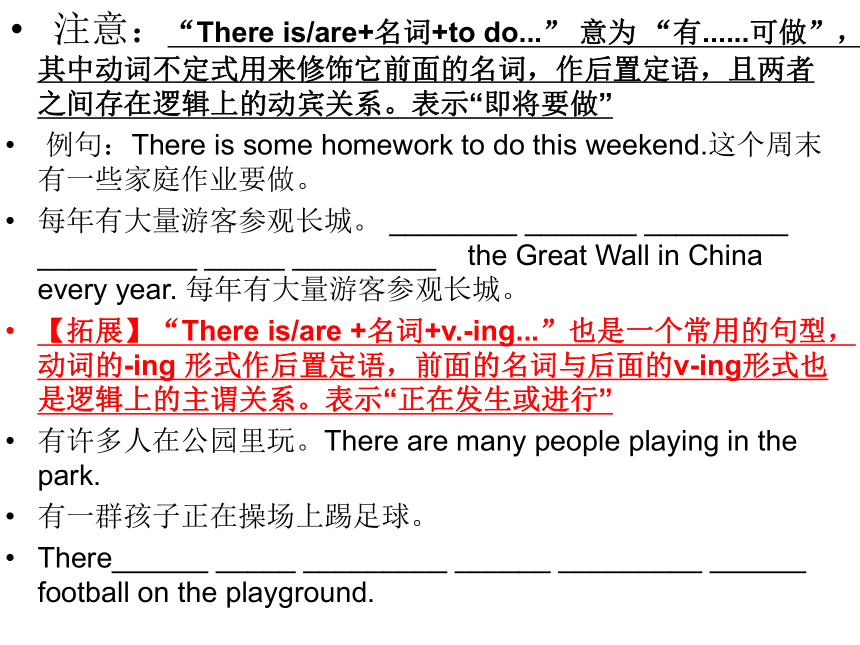
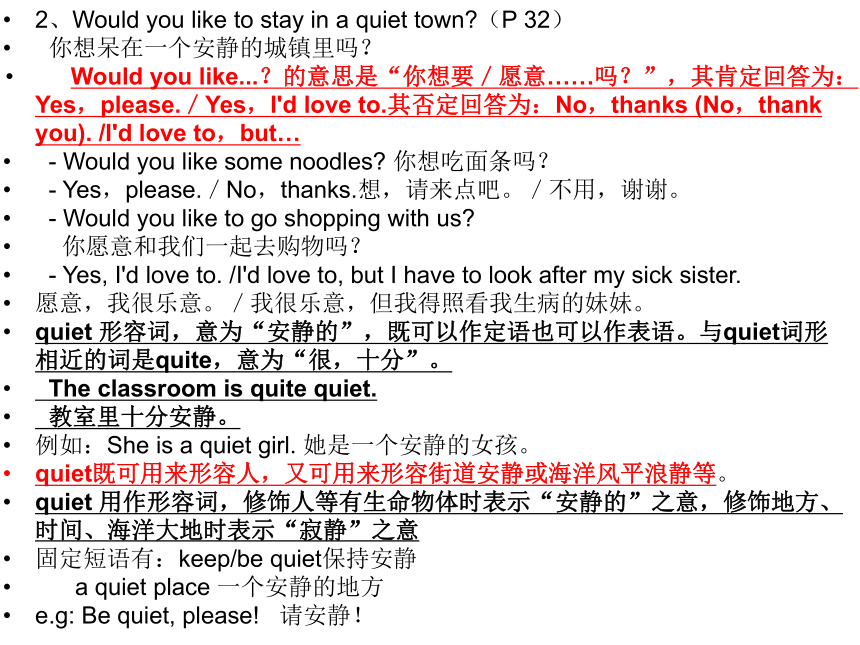
文档简介
(共63张PPT)
7下Unit 3 Welcome to Sunshine Town!全解
Comic strip
1、An old friend of mine is coming to see me, Hobo.(P 30)
① “of + 名词性物主代词”可以做名词的后置定语,有时表部分概念,有时有感彩。a friend of 与后面的名词是“部分关系”,因此后面的名词用复数形式my friends.
例如:Is he a neighbour of yours? 他是你的一个邻居吗?
Look at that big nose of his! 看他那大鼻子!(有贬义)
② “名词 + of + 名词性物主代词/名词的所有格”是双重所有格结构。“双重所有格”是指既含有名词的所有格或名词性物主代词,又含有of 短语的一种表达所有关系的结构。
例如He is a teacher of my sister’s. 他是我妹妹的一位老师。
(2)is coming 用的是现在进行时形式,表示将来将要发生的动作,意思是“将要来”。come,go,leave,arrive等表示位置移动的动词常用现在进行时表示将要发生的动作,它们很少与be going to结构连用。
例:我明天就要动身去上海了。??
2、But there’s nothing in the fridge.(P 30)
Nothing 是不定代词,意为“没有什么”,表否定含义。
例如:----What’s in the room?
----Nothing.
3、Let’s go to the supermarket.(P 30)
Let’s 是let us 的缩写形式。除了us以外,其他代词的宾格与let都没有缩写形式。
Let sb. do sth. 意为“让某人做某事”,do 是省略to的动词不定式,作sb.的宾语补足语。其肯定回答一般为“OK.”“All right.”; 否定回答一般为“Sorry, I …”。
let's与let us
(1) let's是let us的缩写,包括说话人和听话人双方在内,含有催促、建议或请对方一起行动的意思。在听话人表示赞同建议时可只用let's。
- Let's go to Beijing by plane.我们乘飞机去北京吧。
- OK.好的。
(2)当请求对方允许自己(第一人称复数)做某事时,要用let us,这里的us不包括听话方在内,不能缩写为let's。
Please let us remove the bookshelf for you.请让我们给你移动一下书架。
例如:----Let’s go home.
----All right.
----Let’s go and see Uncle Wang!
----OK.
Let me look at it.
4、We only have five yuan, Eddie. (P 30)
Only 此处用作副词,意为“只,仅仅,才”。
例如:Tom is only five years old.
Only 还可用作形容词,意为“唯一的,独有的”,常与单数可数名词连用。当only 与复数可数名词连用时,意为“仅有的”。
例如:Jack is Greens’ only son.
5、Is it enough for a tin of dog food? (P 30)
1).enough adj.(形容词),“足够的”,可作表语;也可作定语,放在被修饰名词的前面和后面均可。 如:20元前就够了。Twenty yuan __________ ___________.
我们有足够的钱。We have enough money.= We have money enough.
2).enough adv.(副词) 修饰形容词和副词时只能放在被修饰词的后面且常与不定式连用。……adj/adv+enough +to do sth.
如:他到了上学的年龄了。He is _______ _________ ______go to school.
她起得早能赶上早班车。She got up ________ __________ ______catch the early bus.
3)be enough for… 意为“对于……来说够了”
a tin of “一听,一罐”。
It’s a tin of meat. 这是一罐肉罐头。
I’d like two tins of cola to drink. 我想要两听可乐喝。
6、Maybe we can order a pizza… 也许我们可以订购一个比萨饼…(P 30)
(1)maybe 副词,意为“大概,可能,或许”,与perhaps同义。
Maybe we can invite them to have dinner with us.
Maybe you are right.
辨析:may be;(may是情态动词,be是连系动词。may be 意为“可能是”)
[辨析] maybe与may be
(1) may be是由情态动词may和连系动词be构成的短语,may的意思是“也许,可能”,be的意思是“是”;may be的意思是“也许是”,后面跟形容词、介词短语、名词等作表语。
It may be Mary’s book. Maybe yours is in your bag.
(2)order 及物动词,意为“订购,预订;叫或点(饭菜、饮料等)”
Let’s order some food. 让我们点餐吧。
拓展:
(1)order 及物动词,意为“命令”
If you make any more noise I’ll order you out of the room.
(2)order 名词,意为“订单,订货”。
This is an order for five hundred bags.
(3)order 名词,意为“次序,顺序”。
Please put them in the right order.
Welcome to the unit
1、I enjoy Chinese food.(P 31)
enjoy 及物动词,意为“享…之乐,喜爱,喜欢”;后接名词、代词或动名词。
enjoy是及物动词,意思是“喜欢,享受……的乐趣”,常构成短语enjoy doing sth.,意为“喜欢做某事”。
I enjoy walking in the cool air.我喜欢在凉爽的空气中漫步。
例如:Do you enjoy your school life?
My elder brother enjoys helping others.
[拓展]:enjoy oneself = have a good time = have fun 玩的愉快
Do you enjoy yourselves at weekends?
2、I love watching films. (P 31)
Watch 及物动词,意为“看,观看”。
例如:I watch TV every day..
I want to watch the basketball game.
[拓展]:
1. watch sb. do sth. 看见某人做过某事
watch sb. doing sth. 看见某人正在做某事
例如:I often watch him dance in the park.
I watched them playing football at six yesterday afternoon.
2. watch 名词,意为“手表”。
This is my watch.
1.Shall we take them to the cinema? 我们要把他们带去电影院吗?
take sb. to ... 把某人带到……,其中to为介词,后面可直接跟地点,即:take sb. to sp.带某人去某地。但若接地点为地点副词(here, there, home等)时,要省略介词to。
e.g: I want to take my little sister to the zoo on Saturday.
星期六我想带我的小妹妹去动物园。
Can you take me there? 你能把我带到那儿吗?
[拓展]take sth. to ... 表示“把某物带给……”,后面可直接跟人,即:take sth. to sb.将某物带给某人。
e.g: Let’s take the food to my grandparents. 让我们把这些食物带给我的祖父母吧。
3,They can try some Chinese food.他们可以试着吃一些中国菜。
(1)用作名词,常构成短语have a try(试一试)。
Why not have a try? 为什么不试一试?
(2)用作动词
①后接名词或代词作宾语。
Please try this new way.请试一下这个新方法。
②try on试穿。
This pair of trousers is very nice. Please try them on.
这条裤子很好,请试穿一下。
③try to do sth.竭力做某事;试图做某事。
We'll try to finish the homework on time.我们将尽量按时完成作业。
④try one's best to do sth.尽某人最大的努力做某事。
I will try my best to help you.我将尽我最大的努力帮助你。
⑤try doing sth.试着做某事。
He is trying riding a bike.他在试着骑自行车。
Reading
1、There are lots of things to do in Sunshine Town. (P 32)
“there is/are + 名词+ to do….” 意为“有…可做”,其中动词不定式用来修饰它前面的名词,作后置定语,且两者之间存在逻辑上的动宾关系。
[注意] 动词不定式作后置定语时该动词必须是及物动词,如是不及物动词须加上适当的介词但不能再接宾语,因为被它修饰的名词或代词即为它的逻辑宾语。
something to eat吃的东西
(eat为及物动词,但后面没有接宾语,因为something即为eat的逻辑宾语)
a book to look for 一本要寻找的书
(look为不及物动词,所以要加上介词for,但后面不能接宾语,因为a book即为look for的逻辑宾语)
例如:There is some homework to do this weekend.这个周末有一些家庭作业要做。
There are some things to buy in the town.镇里有许多要买的东西。
我有一首歌要听。
I have a song________ ________ _______.
注意:“There is/are+名词+to do...” 意为 “有......可做”,其中动词不定式用来修饰它前面的名词,作后置定语,且两者之间存在逻辑上的动宾关系。表示“即将要做”
例句:There is some homework to do this weekend.这个周末有一些家庭作业要做。
每年有大量游客参观长城。 ________ _______ _________ __________ _____ _________ the Great Wall in China every year. 每年有大量游客参观长城。
【拓展】“There is/are +名词+v.-ing...”也是一个常用的句型,动词的-ing 形式作后置定语,前面的名词与后面的v-ing形式也是逻辑上的主谓关系。表示“正在发生或进行”
有许多人在公园里玩。There are many people playing in the park.
有一群孩子正在操场上踢足球。
There______ _____ _________ ______ _________ ______ football on the playground.
2、Would you like to stay in a quiet town?(P 32)
你想呆在一个安静的城镇里吗?
Would you like...?的意思是“你想要/愿意……吗?”,其肯定回答为:Yes,please./Yes,I'd love to.其否定回答为:No,thanks (No,thank you). /I'd love to,but…
- Would you like some noodles? 你想吃面条吗?
- Yes,please./No,thanks.想,请来点吧。/不用,谢谢。
- Would you like to go shopping with us?
你愿意和我们一起去购物吗?
- Yes, I'd love to. /I'd love to, but I have to look after my sick sister.
愿意,我很乐意。/我很乐意,但我得照看我生病的妹妹。
quiet 形容词,意为“安静的”,既可以作定语也可以作表语。与quiet词形相近的词是quite,意为“很,十分”。
The classroom is quite quiet.
教室里十分安静。
例如:She is a quiet girl. 她是一个安静的女孩。
quiet既可用来形容人,又可用来形容街道安静或海洋风平浪静等。
quiet 用作形容词,修饰人等有生命物体时表示“安静的”之意,修饰地方、时间、海洋大地时表示“寂静”之意
固定短语有:keep/be quiet保持安静
a quiet place 一个安静的地方
e.g: Be quiet, please! 请安静!
1、The air is fresh here. (P 32)
(1)air名词,意为“空气,大气”,为不可数名词,单独使用时要与定冠词the连用。
e.g: The air here is very clean. 这儿的空气非常干净。
[拓展]
类似air表示世界上独一无二的东西的单词有:the Earth 地球
the Sun 太阳 the Moon 月亮
(2)fresh 形容词,意为“新鲜的,清新的,凉爽的”,在句中作定语或表语。
fresh 用作形容词,意思是“新鲜的”。常指空气、水、水果、蔬菜、鱼、肉等“新鲜的”,也可以指人的思维、人的言行是“新鲜的”、不同凡响。
例如:Fresh milk is good for children. 鲜奶对孩子们有益。
2.It takes only 40 minutes by underground.
乘地铁只需40分钟的时间。
take在此意为“花费”,常构成句型“It takes sb. some time to do sth.”意为“做某事花某人一些时间”。
It takes me half an hour to read English every morning.
每天早晨读英语花我半小时的时间。
( )①It takes him an hour ________the book.
A. buying B. to buy C. to buying D. buy
by underground的意思是“乘地铁”,类似短语有by bus/train/plane/bike等。
Do you usually go to work by underground?
你通常乘地铁去上班吗?
[注意] by underground相当于on the/an underground,在句中作状语。作谓语时要用 take the/an underground。上句又可以表达为:
Do you usually take the/an underground to work?
②你们可以乘地铁去公园。
You can________ _______ the park_______ _______.
4、Beijing duck is very famous. (P 32)
famous 形容词,意为“著名的,有名的”,既可以作表语,也可以作定语。其同义词是well-known, 反义词是unknown.
例如:Chinese silk is famous around the world. 中国丝绸世界闻名。
【拓展】:
1.be famous for… “因…而著名/出名”。
New York is famous for its skyscrapers. 纽约因它的摩天大厦而闻名。
2.be famous as… “作为…而出名”。
Mo Yan is famous as a writer. 莫言作为一名作家而出名。
(1)当主语是表示人的名词时,be famous for表示“以某种知识、技能、作品或特征而出名”,be famous as 则表示“以某身份而出名”。试比较:
Einstein was famous for his Theory of Relativity.爱因斯坦以他的相对论而著名。
Einstein was famous as a great scientist.爱因斯坦以一位伟大的科学家而著称。
(2)当主语是地点名词时,be famous for 表示“以某种特点(产品)而出名”;be famous as 则表示“以什么样的产地而出名”。如:
Scotland has many lakes and mountains, and is famous for its beautiful countryside.苏格兰有许多湖泊和山脉,并以其乡村美景著称。
The area is famous as a green tea producing place.这个地区以绿茶产地而出名。
(3)当主语是事物名词时,be famous for表示“以其内容、特征、价值等而被人所知”;be famous as 则表示“以某种形式出名”。如:
This grammar book is famous for its practical usage. 这本语法书以其实用性而被人所知。
This book is famous as a reference book.这是一本有名的参考书。
5、If you do not like Chinese food, there are some Western restaurants too. (P 32)
1. 这是一个复合句,句中含有一个if引导的条件状语从句。此时,if意为“如果,假如”。
例如:If you come to this city, please call me. 如果你来到这个城市,请给我打电话。
【拓展】:在含有if引导的条件状语从句的主从复合句中,主句用一般将来时,从句常用一般现在时表示将来。
We won’t go to the park if it rains tomorrow. 如果明天下雨,我们就不去公园了。
2.Western adj. 西方的 . west n.西方 Western通常与名词连用而west, 通常用在词组in the west (of).......
如:西方国家 Western countries 西方人 Western people 在西方 in the west
在中国的西部 in the west of China=in the Western part of China
2.western形容词,意为“西方的”,是由方位名词west加后缀-ern构成的。
e.g: In Western countries, Christmas is very important.
在西方国家,圣诞节非常重要。
[拓展]表示“方位”的词形变化:
east 东;东方 →eastern 东方的;东部的
west 西;西方 →western 西方的;西部的
south 南;南方 →southern 南方的;南部的
north 北;北方 →northern 北方的;北部的
3.too 副词, 意为“也,还”,一般位于肯定句句末。
Mike speaks English. And he can speak French too.迈克讲英语,他也会讲法语。
6、Why not visit our local theatre and enjoy Beijing opera?(P 32)
Why not do sth. ? 意为“为什么不做某事呢?”,后接动词原形,用来向对方提出建议,相当于“Why don't you…?”。
例如:If you are free tonight, why not watch a film with me?
Why not put on more clothes?
= Why don't you put on more clothes? 为什么不多穿点衣服?
[拓展]表示建议、邀请的句型归类:
①Let’s do sth., shall we?让我们做某事,好吗?
②Shall we do sth.? 我们做某事,好吗?
③What/How about doing sth.? 做某事怎么样?
④You’d better do sth. 你最好做某事。
7、…don’t miss the open shows there. (P 32)
Miss 及物动词,意为“错过,未看到,未赶上”,后接名词、代词或动名词。
例如:Bob loves football. He never misses any football game.
【拓展】:
1.miss 及物动词,意为“想念,思念”,后接名词,代词或动名词。
She misses her mother very much.
2.Miss 表示“小姐”之意时,应该大写首字母。
Miss Wang is not in the office now.
8、We are looking forward to meeting you soon. (P 32)
1. look forward to (doing) sth. 意为“盼望(做)某事”,其中”to”为介词,其后跟名词或动名词形式。
例如:Most children look forward to the Spring Festival.
The boys are looking forward to having a party.
2.soon 副词,意为“不久”,指现在或指定时间后不久,一般用于将来时。
例如:Mr Li is excited because he will have a long holiday soon.
[拓展]:how soon 意为“多快,多久”,常对“in+段时间”进行提问。
例如:----How soon can you finish it? 你多久能完成它?
----In a week. 一周后。
Grammar
【当别人不耐烦时,你应该这样说】
1)Take it easy.别着急2)Just calm down.冷静点3)Be more patient. 要耐心4)Take your time.慢慢来5)All in good time.不要太着急了6)No rush慢慢来7)There's a time for everything.事情要一件一件地做。8) Keep Calm, Don't lose your temper. 淡定,别发火。
1.I would like to take the boys to our school's football field.
我想把这些男孩子带到我们的学校足球场去。
“school's”这种形式在语法上叫名词的所有格。名词所有格是名词和代词的一种变化形式,在句中表示与其他词的关系。名词有三个格:主格、宾格和所有格。在英语中有些名词可以加“’s”来表示所有关系,带这种词尾的名词形式称为该名词的所有格,如:a teacher's book 一位老师的书。
具体构成方式如下:
(1)在名词词尾加“’s”。主要表示有生命的事物或自然界独一无二的事物以及时间距离等所有格,如:the world's,the Sun's,the Earth's,today's等。
①单数名词词尾加“'s”,复数名词词尾没有“s”,要加“'s”。
the boy's bag男孩的包 men's shoes‘男鞋
②若名词已为复数,词尾又是“s”,只加“’”。
the students' classroom学生们的教室
③凡不能加“'s”的名词,都可以用“名词+of+名词”的结构来表示所有关系。
the name of the book书的名字
④在表示店铺或教堂的名字或某人的家时,名词所有格的后面常常不出现它所修饰的名词。 the doctor's医务室
⑤如果两个名词并列,并且分别有“'s”,则表示“分别有”;只有一个“'s”,则表示“共有”。John's and Mary's rooms约翰的和玛丽的房间(两间)
John and Mary's room约翰和玛丽的房间(一间)
⑥作为一个整体的短语,一般在最后一个名词的词尾加“'s”。
an hour and a half's walk 一个半小时的步行路程
⑦不定代词后接else,所有格放在else上。
somebody else's bag某人的包
⑧起修饰作用的名词,如不表示所有关系,通常不用“'s”。
room number房间号码
(2)另外一种所有格是由介词of加名词构成的名词短语。
①表示所有关系的用of介词短语。
The students of our school come from the countryside.我们学校的学生来自农村。
②表示同位关系的用of介词短语。
the city of Beijing北京城
③表示部分或全部的用of介词短语。
the door of the room房间的门
④表示抽象概念的用of介词短语。
the cost of success成功的代价
(3)双重所有格
双重所有格即“of+名词‘'s’,所有格”,表示整体中的一个或部分。用于修饰of前面的名词,但此时of前面的名词一定要有一个a(an),two,any,some,several,no,few,another或this,that,these,those之类的修饰语(这个修饰语一般不能是one和the)。双重所有格也可由“of+名词性物主代词”构成。
a friend of mine我的一位朋友
Do you know any friend of my husband's? 你认识我丈夫的任何一个朋友吗?
Two classmates of my sister's will come to see me.我姐姐的两个同学将来看望我。
1、Neil’s mother is calling him from the UK.(P 35)
Call 此处用作及物动词,意为“打电话”。
例如:My friend often calls me from Beijing at weekends.
[拓展]:
1.call 及物动词,意为“叫,呼唤”。
Call a taxi for me.
2.call 及物动词,意为“称…为…”。
His friends call him Bob.
3.call 还可用作名词,意为“打电话,通话”。
There is a call for you, Mr Black.
关于打电话的说法有:
call/ring sb. call/ring sb. up phone/telephone sb.
make a telephone/phone call to sb. make telephone/phone calls to sb.
2.Whose postcards are these?这些是谁的明信片?
- They're Millie's.它们是米莉的。
whose用来对名词的所有格提问。
- Whose English book is this? 这是谁的英语书?
- It's Tom's.是汤姆的。
Whose key ring is that? 那是谁的钥匙圈?
(1)key名词,意为“钥匙”,复数为keys
eg: There are three keys in my bag. 我包里有三把钥匙。
[拓展]key作为名词,还可表示“答案;关键;键” the key to… …的答案;…的关键
key表示“键”之意时,是指电脑、打字机、钢琴等“键盘上”的“键”。
key 也可以用作名词,表示“关键”性的人或人事。
eg: Do you know the key to the second question? 你知道第二个问题的答案吗?
(2)ring 名词,意为“环,圈“,复数为rings
eg: The dog has a ring on its neck. 这条狗的脖子上有一个圈。
[拓展]①ring作名词,还可表示“戒指”
eg: My mother wants to buy a new ring. 我妈妈想要买一枚新戒指。
②ring还可作动词或名词,意为“打电话;电话”
eg: I’ll ring you back as soon as possible. 我将尽快给你回电话。
2、There are lots of nice shops in our town.(P 35)
Lots of = a lot of 意为“许多”,后面既可接可数名词复数,又可接不可数名词,多用在肯定句中。在疑问句中和否定句子中常用many或much,many后接可数名词复数,而much后接不可数名词。
例如:We have lots of/a lot of new books.
He doesn’t have many friends here.
There isn’t much milk in the bottle.
3、They’re all over the place.(P 36)
All over 意为“遍及”,over 在此处作介词,意为“遍及”
(1)all over 表示“到处”之意时,与副词everywhere 意义接近。
(2)all over 表示“遍及”之意时,相当于介词throughout ,后面要接名词、代词等作宾语:
例如:all over China 遍及全中国 all over the world 全世界
Scientists from all over the world are here for an important meeting.
物主代词
名词性物主代词=形容词性物主代词+名词
为避免重复使用名词,有时可用“名词性物主代词”来代替“形容词性物主代词+名词”的形式。
例:My bag is yellow, her bag is red, his bag is blue and your bag is pink.
为避免重复使用bag,可写成My bag(形容词性) is yellow, hers(名词性) is red, his(名词性) is blue and yours(名词性) is pink.
用法:
1)物主代词既有表示所属的作用又有指代作用,例如:
John had cut his finger; apparently there was a broken glass on his desk.
约翰割破了手指,显而易见,他桌子上有个破玻璃杯。
物主代词有形容词性(my, your等)和名词性(mine, yours等)两种,形容词性的物主代词属于限定词。
名词性的物主代词在用法上相当于省略了中心名词的 --'s属格结构,例如:
Jack's cap 意为 The cap is Jack's.
His cap 意为 The cap is his.
2) 名词性物主代词的句法功能
a. 作主语,例如:
May I use your pen? Yours works better.
我可以用一用你的钢笔吗? 你的比我的好用。
b. 作宾语,例如:
I love my motherland as much as you love yours.
我爱我的祖国就像你爱你的祖国一样深。
c. 作介词宾语,例如:
You should interpret what I said in my sense of the word, not in yours.
你应当按我所用的词义去解释我说的话,而不能按你自己的意义去解释。
d. 作主语补语,例如:
The life I have is yours. It's yours. It's yours. 我的生命属于你,属于你,属于你。
例句:This is my case.
This case is mine.在这里的mine带有“我的(书)”的意思。
This book belongs to me.
用名词性物主代词,一般来说,人称代词都要有所变化,特别是I,不是"mys”,要注意。
(3)名词性物主代词可以用在介词of的后面,相当于“of+名词所有格”。
a. –‘s所有格
表示有生命的人或物的名词所有格,单数名词和不以s结尾的复数名词通常在词尾加“s”;以s结尾的复数名词只在词尾加“’”。
My elder brother’s bike 我哥哥的自行车
Children’s Day 儿童节
Students’ books 学生读物
【拓展】
(1). 如果所指人或物为两个人或几个人所共有,则只在最后一个名词后加”s”。
This is Jane and Mary’s room. 这是简和玛丽(共有的)房间。
Lily and Lucy’s mother is a doctor. 丽丽和露西的妈妈是一位医生。
(2). 如果所指人或物为各自所有,则应在每个名词后都加“s”。
These are Jane’s and Mary’s rooms. 这些是简和玛丽(各自)的房间。
Lily’s and Lucy’s mothers are both doctors. 丽丽的妈妈和露西的妈妈都是医生。
b. of 所有格
无生命事物名词的所属关系,常用“of+名词”来表示。即of所有格。
the capital of China 中国的首都 the name of the river 这条河的名字
主格 宾格 所有格 物主代词
I me my mine
He him his his
she her her hers
you you your yours
物主代词用法歌诀
物主代词两类型,形容词与名词性。
形容词性作定语,后面定把名词用。
名词性要独立用,主宾表语它都充。
Integrated skills
1.Don't miss them,别错过(这次盛大的展览)。
miss用作动词,在此意为“错过”。
I miss the beginning of the film.我错过影片的开头。
Don't miss the early bus.不要错过早班车。
[知识拓展] (1)miss用作动词时还有“想念,思念”之意。
I miss my parents very much.我非常想念我的父母。
(2) miss的首字母大写(Miss),意为“女士,小姐”,对未婚女子的尊称。
Where is Miss Li from?李小姐来自哪里?
我经常错过第一节课。 I often________ _______ _______ class.
Hunagji Palace---Chinese paintings
painting名词,意为“绘画,油画”,复数为paintings. 动词为paint(刷,涂);painter名词,意为“画家,油漆工”
eg: Qi Baishi is good at drawing Chinese paintings. 齐白石擅长画中国画。
Paint a picture in oils. 画一幅油画。
Look! The painters are painting the building. 看!油漆工们正在给大楼刷漆。
1、You can learn all about old China at the museum. 在博物馆你可以了解到古老中华的一切。
句中learn 是“了解”的意思,如:
He learns a lot about computers. 他对计算机了解得很多。
I read newspapers every day because I want to learn more about the world.
我每天看报学习,因为我要更好地了解世界。
learn 和study都有“学习”的意思,它们有时可以互换。
一般说来,learn侧重于通过受教育掌握某种技巧,有“学会,学到”的意思,强调学习的成果。学习做具体的事情要用learn, 而不用study。
study还有“研究”的意思,强调了学习的过程。除此之外,study还可用作名词“书房”。如:Let’s learn to speak Japanese. 咱们学习讲日语。
We learned a lot from the book. 我们从这本书里学到了许多东西。
My father is a Maths teacher. He often studies Maths when he is free.
我父亲是个数学教师。他经常一有空就在研究数学。
He studied hard and at last he learned this lesson. 他努力学习,最后学会了这篇短文。
Look! He is studying in the study. 看!他正在书房里学习。
1、Go to Huangji Palace to see works of art at 11 a.m. (P 38)
Works of art 意为“艺术品”,此处works 是work的复数形式。Work 当“作品,著作”讲时,为可数名词。
例如: Wang Gang likes to collect works of art.
I’d like to learn more about Chairman Mao’s works.
[拓展]:work 意为“工作,劳动”时,为不可数名词。
They have much work to do.
2、That’s fine.(P 38)
Fine 形容词,意为“美好的,优良的,杰出的”。
例如: What a fine view it is!
[拓展]:
1.fine 形容词,意为“晴朗的”,用来形容天气时,和clear同义。
What a fine day!
2.fine 形容词,意为“安好的。(身体)好的”,相当于well。
----How are you?
----I’m fine.
3、How far is it from the hotel?(P 38)
How far 意为“多远”,用于对距离进行提问。
例如: ----How far is it from here to the park?
----It is two kilometers.
4、It’s about 40 minutes by bus.(P 38)
“it is +所需时间+(from A to B+)by+交通工具/on foot.”是一个表达(从A地到B地)距离的句型,有时它可用“it is+所需时间名词的所有格+ walk/ride/drive(from A to B).”替换。
例如: It is about four hours from Lianyungang to Nanjing by car.
=It is about four hours’ drive from Lianyungang to Nanjing.
5、We’ll have a good time there!(P 38)
Have a good/great/wonderful time 意为“玩的开心、愉快”,其中的冠词a 不可省略。Have a good time 和have fun/enjoy oneself 同义,其后都可以接doing sth. ,意为“在做某事中过的愉快”。
例如: Li Ming is having a good time in the park now.
We have a good time cleaning the classroom.
Study skills
3.My pen is broken.I want to buy a new one.我的钢笔坏了,我想买一支新的。
(1) one作代词的用法如下:
①one替代由可数名词所表示的一类人或事物中的任何一个,这时,one前面不可加任何限定词。
Your glass looks very nice. I want to have one too.
你的玻璃杯看上去挺好的。我也想有一个。
②one用来替代特指的同一类人或事物的可数名词,其前面必须加上限定词(a,the,this,that等)、物主代词或形容词加以修饰。
If you don't like this blue coat, you can buy a black one.
如果你不喜欢这件蓝色的外套,你可以买一件黑色的。
③one的复数形式为ones,作替代词时,只可替代同一类人或事物的复数名词,其前面必须有限定词,如the,some,all等修饰,但不能用数词或many修饰。
I don't want to buy these small pears. I want some big ones.
我不想买这些小梨,我想买些大的。
(2)it的用法如下:
①it用来替代前面提到的同一事物,被替代的名词可以是可数名词,也可以是不可数名词。
I have a book with many pictures in it.
我有一本里面有许多画的书。(it替代可数名词book)
I don't like the bread. It is too hard.
我不喜欢这个面包,它太硬了。(it替代不可数名词bread)
②it可以替代不定式(短语)、动名词(短语)或从句,在句中作形式主语或形式宾语。
It is nice to see you again.
再次见到你真是太好了。(it作形式主语,真正的主语为不定式短语to see you again)
I think it is important to learn English well.
我认为学好英语是重要的。
(it作形式真语,真正的宾语为不定式短语to learn English well)
简单点说one是“同类不同个”, it就是同一个!
one与it都可替代上文出现的某个名词,但用法不同。one用来指上文出现的某物中的一个,it指上文中的那个物。
下面我们来仔细比较下:
两者均可代替前面提到的事物,区别是:it指的是与前面已提到的事物为同一物,此时的it等于“the (this, that, my...)+名词”;而one 指的是与前面已提到的事物为同一类物,此时的one等于“a+名词”。比较:
I have a dictionary but I’ve lent it to Mary. 我有一本词典,但把它借给玛丽了。
I haven’t a dictionary; can you lend me one? 我没有词典,你能借我一本吗?
包括it的习语很多,比如make it就是其中很重要的一例。如:
You can make it if you hurry. 如果你赶快还可以及时赶到。
He wants to make it as a writer. 他想作一名作家而一举成名。
You needn’t worry; he will make it. 你不必担心,他会办成的。
one作代词的用法如下
1.one替代由可数名词所表示的一类人或事物中的任何一个,即泛指中的强调.这时,替代词one前面不可加任何限定词.例如:
1)I hope there are enough glasses for each guest to have one.
2)A color TV set made in Japan costs more than one made in China.
3)-Who can lend me a Chinese-English dictionary?
-I have one.
2.one用来替代特指的同一类人或事物的可数名词时,其前面必须加上限定词(如a,the, this, that等)、物主代词或形容词加以修饰.例如:I don't want the book on the shelf, I want this one on the desk.
Your old bike is white, while my old one is black.
3.one在定语从句中作先行词替代特指的同一类人或事物时,其前面必须用定冠词the限定,但不可用that替换.如果先行词为"one of...",其关系代词在定语从句中作主语,从句中的谓语动词常用复数形式.例如:
1)This farm is the one that we visited last summer.(句中the one代替this farm,作先行词,不可用that替代)
2)This is one of the highest buildings that have been built in our city recently.
3)Zhang Lei is the very one of the students who has been praised at the meeting.
4.one的复数形式为ones,作替代词时,只可替代同一类人或事物的复数名词,其前面必须有限定词,如the, some, all等修饰.但不能用数词或many修饰.例如:
1)Mr. Zhang gave the textbooks to the pupils except the ones who had already taken them.(句中the ones可用those替代)
2)I don't want to buy these small pears; I want some large ones.
3)She wants to buy some new clothes and throw away all her old ones.
5.one在句中不可替代不可数名词.在句中如果出现了同一个不可数名词时,则需要重复前一个名词,或者省略那个名词.例如:
1)I prefer black coffee to white (coffee) .(white coffee中的coffee可省略也可不省,但不可用one替代coffee)
2)Folk music is the music that I like most.(不可用the one替代the music)
it作代词如何使用:
1.it用来替代前面提到的同一事物时,被替代的名词可以是可数名词,也可以是不可数名词.例如:
1)We are studying in a school with trees all around it.(it替代可数名词school)
2)-Have you still kept your old furniture?
-No,I have sold it.(it替代不可数名词furniture)
2.it可以替代英语句式中的不定式(短语)、动名词(短语)或从句,在句中作形式主语或形式宾语.例如:
1)It is a great surprise to meet you here.(It替代不定式短语to meet you here)
2)I think it is no good parents doing anything for their children.(it替代动名词的复合结构parents doing anything for短语)
3)We found it impossible
1.I am talking about a CD, not something else.我在谈论一盘CD,而不是其他东西。
(1)else作副词,意为“其他的,其余的”,后置修饰不定代词(something, anyone, nothing等)、疑问代词(who, which, what等)及疑问副词(when, where等)。
Would you like to tell me something else? 你愿意告诉我一些其他的事情吗?
What else do you see? 你还看到其他什么东西了?
Where else do you go? 你还去其他什么地方了?
(2) other作形容词,前置修饰名词。
What other books do you read? 你还读了其他什么书?
( )What_______ do you buy in the shopping mall?
A. other B. else C. the other D. the else
Task
1、I’m going to show you around my hometown.(P 41)
Show sb. around/round…意为“带领某人参观”
例如:This afternoon, I will show the visitors around our school.
[拓展]:
1. show 及物动词,意为“给…看”。
Show sb. sth.= show sth. to sb. 给某人看某物
Please show me your ticket. = Please show your ticket to me.
2. show 可数名词,意为“展览”。
a dolphin show 海豚展 a flower show 花展 be on show 展出
拓展一些有关于show的词组:
show off 卖弄, 炫耀 陈列; 使显眼 show oneself 出现, 露面
show up 到席, 露面; 显眼; 暴露; 揭发; 嘲笑; 使人难堪
2、Every day, I can smell the flowers and hear the birds sing. (P 41)
① smell 动词,意为“闻到,嗅到”。
I think I can smell gas. 我想我闻到了煤气味。
[拓展]:
1.smell 作连系动词,意为“闻起来”,其后接形容词作表语。
The flowers smell good.
2. smell 作可数名词,意为“气味”。
It gives off a good smell.
② hear sb. do sth. 意为“听见某人做某事”,暗示该动作已经完成或经常发生。hear sb. doing sth. 意为“听见某人正在做某事”,强调动作正在进行。
例如:She hears someone come into the room.
Who can you hear singing in the next room now?
[拓展]:除hear 外,see/watch/feel/notice等动作也有同样的用法。
hear可用作及物动词,也可用作不及物动词,意为“听见,听到;听说 ”,强调听的结果。
hear常见的搭配有:hear sb.doing sth. (听到某人正在做某事);hear sb. do sth. (听到某人做了/ 常做某事);hear from sb. (收到某人来信);hear of sb. /sth.(听说某人/某事)等。如:
I can’t hear you. Can you say it loudly? 我听不见你的话,能说高一点吗?
We heard the children singing in the classroom at 9 last night.
昨晚九点钟我们听到孩子们在教室里唱歌。
listen表示有意识地听、仔细听,强调听的动作。listen to, 意为“听……(人、事)”。如:
Listen! Who is crying in the next room? 听!谁在隔壁房间里哭?
sound意为“听起来,听上去”,常用作系动词,其后跟形容词作表语,还可以与like搭配使用。如:
He told me about the book – it sounded interesting.
他告诉了我有关这本书的情况——这听起来很有趣。
3、Sometimes we row a boat there.(P 41)
Sometimes 副词,意为“有时”,相当于 at times。
例如:He sometimes goes to school on foot.
【辨析】:sometimes, some times, sometime与some time
例如:She comes to visit us sometimes.她有时来看望我们。
Lucy has been to Beijing some times.露西去过北京几次了。
Jack will leave for America sometime next week. 杰克将在下周某个时候动身去美国。
I need some time to do my homework.我需要一些时间来做作业。
sometimes 频率副词 有时 表示动作发生的不经常性,多与一般现在时连用,它可位于句首、句中或句末,对它提问用how often
some times 名词短语 几次,几倍 其中time 是可数名词,对some times 提问用how many times
Sometime 副词 某时 表示某个不确切或不具体的时间,常用于过去时或将来时,对它提问用when
some time 名词短语 一段时间 表示“某一段时间”时,常常修饰延续性动词,对它提问用 how long
4、Some families raise cows, and others grow wheat.(P 41)
一些家庭饲养奶牛,还有一些家庭种小麦。
some…others…意为“一些……,另一些……”,表示除去一部分以后的另一些,但不是剩下的全部。
例如:Some people like singing, and others like dancing.
There are many people on the train. Some are chatting; others are sleeping.
[拓展]:some… the others…意为“一些……,其他的……”,表示一定范围内除去一部分后其余的全部。
There are 40 students in my class. Some are Americans, and the others are Chinese.
one …. the other (两者中)一个….另一个
one ….another (三者或以上中) 一个….另一个
raise在此意为“饲养”。
She likes raising dogs.她喜欢养狗。
[知识拓展] raise还有如下用法:
(1)举起;抬起;扬起;升起。
Let's raise glasses to the friendship.让咱们为友谊干杯。
If you have any question to ask,raise your hand,please.有问题请举手。
(2)提高(音量等);使(某人)晋升。
He raises his voice.他提高了声音。
(3)招募;筹集。
They raise money for the school.他们为学校筹集资金。
[辨析] rise, raise
rise(rose, risen)vi. 上升,升起, 升高;上涨;站起来。说明主语自身移向较高位置,常用于日、月、云、雾、烟、蒸汽、河水、温度、物价以及人的职位等,无被动语态。 如:
The moon has risen above the hills. 月亮已经从山上升起。
The river has risen by several meters. 河水上涨了好几米。
raise vt. 举起,提起;抬高;筹集。说明主语发出的动作是要作用于其它事物的,往往有使物体达到其应有的高度的含义。可用于被动语态。如:
Heavy rain raised the river stage. 暴雨使河水水位升高。
The boss promised to raise her salary.老板答应要给她加薪水。
4.People here know each other.这儿的人互相认识。
句中know意为“认识,熟悉”,“非常熟悉”用know…well表示。
如:I know Smith very well. I got to know him 10 years ago. 我非常熟悉史密斯,我10年前就认识他了。
each other用作动词或介词的宾语,若动词是及物动词就直接跟each other,不加介词;若是不及物动词就要加介词。如:
We must help each other. 我们必须互相帮助。(help是及物动词)
They looked at each other but said nothing. 他们互相看看,什么也没说。(look是不及物动词)
each other的意思是“相互”。
Do you often write to each other? 你们经常相互写信吗?
5、They are all friendly.(P 41)
friendly 形容词,意为“友好的”。be friendly to sb. 意为“对某人友好”,指对某人的态度好、热情,相当于be kind to sb.。be friendly with sb. 意为“和某人关系好”或“与某人要好”,指的是两者的关系。
例如:My classmates are all friendly to me.
He’s not very friendly to newcomers.
The classmates in our class are friendly with each other.
6、Usually my mother drives us there to do the shopping.(P 41)
Drive此处用作及物动词,意为“驾车送(人)”。”drive sb. to+ 地点名词”意为“驾车送某人去某地”。
例如:My father buys a new car. He will drive us to school tomorrow.
drive用作及物动词,意为“驾车送(人),驾驶”,后接人时,表示“驾车送”,后接车时,表示“驾驶”。
7、I hope you can come and visit soon!(P 41)
hope及物动词,意为“希望”,用于表示有可能实现的愿望,其后可接动词不定式作宾语,即hope to do sth. , 意为“希望做某事”。若表达“希望……”则需用”hope + that从句”。
例如:I hope to go to Tibet some day in the future.
I hope that you can study harder.
[辨析]:hope与wish
二者都可意为“想,希望”。宾语都可以是to do sth.,不能是doing sth.
hope hope for+名词,可实现的愿望 hope + that从句,“希望……”,陈述语气
wish wish for +名词,难以实现的愿望 wish + that从句,“希望……”,虚拟语气
1介绍自己家乡的短文体裁虽然可以多样化,但用得较多的还是描写文体载。所谓描写文,是指用生动的语言描写各种事物、地点、环境以及人物的状态、表现等的一种文体。在写描写文时,要尽可能把自己平时所观察到的人物或景物细节写出来,适当可以表达自己的情感和情绪。
2对于家乡的描写,可以描写家乡的地理位置、景观、气候、特色等几个方面,称为客观描写;也可以借景抒发自己的情感,称为主观描写。
3对于家乡的介绍,常采用地点的空间方位作为介绍的顺序;它能把复杂的地理位置,通过分层说明,详尽而有条理地解说清楚,给读者一个具体的位置,清晰的印象。
根据说明地点结构特点、介绍顺序一般有定位观察顺序和移位观察顺序。
1.定位观察顺序
先确定一个固定的观察点,然后或上或下,或左或右,或远或近,按合理的顺序,从不同的方位、角度来介绍说明某个地点。
2.移位观察顺序
一般按作者的游览顺序。依次设立一个个观察点,逐步逐层对地点进行介绍。
(A)(基础)
My home town is not very modern, but it’s a beautiful place. It’s at the foot of green mountains. There’s a river beside it, and there’s a primary school beside the river. Some boys and girls usually swim in it. There are many wide fields around my home town.
Now people in my home town live a rich life. In the morning, people go to work with happy songs. In the evening, they go home happily.
My home town is a wonderful place. It is full of happiness and laughter I love my hometown, and I love people here. They are healthy and friendly. They are making our home town better. Really, there is no place better than my home town.
(B) (提升)
Dear Andy,
I love the city you are living in. There are so many interesting things in your daily life. My hometown is a small village called ××, not far away from ××city. I live on a farm. There are many animals on the farm. They are pigs, chickens, sheep, cows and horses. I like my hometown, because I can hear birds sing and sheep bleat. I can see the blue sky and green hills. I can swim in the clean river near my house in summer. If you have time to come to my hometown some day, I’ll be very glad to show you around the farm.
I look forward to hearing from you soon.
Yours faithfully
Zhao Bin
你会阅读吗?
英语阅读不仅能培养学生英语语感,还能促进词汇积累,提高写作水平,是培养学生英语综合能力的主要途径之一。如何进行有效的阅读呢?
1.克服不良习惯
在阅读前,首先要作好心理准备,集中精力,全身心的投入到阅读活动中。阅读过程中要努力克服阅读时转动头部、指词、逐词阅读、回视、唇读、喉读、心读等不良习惯,要尽可能地眼脑直映,扩大视距,掌握快速阅读技巧。
2.猜测法
对阅读中出现的新词,要主动、大胆的根据上下文、构词法知识和常识猜测词义。对那些不影响全篇大意的新词,少查字典;对那些频频出现的新词,而应多查词典。而且,查字典的时间应该是在阅读完后,而不是在阅读中,否则思路被打断,会影响阅读的速度和效果。
3.略读法
运用略读(skim)、扫读(glance)方法,理解掌握文章大意。略读就是快速浏览文章的标题、文章的首尾段、每段的首尾句、关键词和图表等,把握文章的主旨。初阅读时一般宜采用略读法,略读不需要掌握具体内容,此法最适合处理与文章主旨有关的文章。
4.跳读法
跳读与略读不同,它不要求了解中心内容,只需了解某一特定的内容。通过跳读,仔细阅读相关部分,了解其内容,理解其深层含义。要获取一些信息时可以采用跳读法,回答与文章具体内容相关的问题时,运用这种方法最好。在文章中找到与题目相关的部分,就很容易找到正确答案。
5.积累好词好句
阅读主要是训练阅读技巧,同时也是学习新语言点的好机会,对于经常出现的有用的单词或句型,可以划线或者记笔记,积累语言知识。
6.关注关联词
要学会利用词汇的衔接手段(语义重复、替代等)猜测生词的意思,还要学会利用关联词分析时间、空间、因果关系及作者的态度等。
China's和Chinese的区别
代表国家的专有词“China's,Chinese”都可修饰名词,但用法又有所不同。
首先做一个分析,Chinese同样既可用作名词,又可用作形容词,作名词时意为“中国人,汉语,中文”,作形容词时意为“中国的,中国人的,汉语的,中文的”;China's是China作名词时的所有格形式,作名词的后置修饰语,它们都可以修饰名词,其主要区别如下:
China's与Chinese的用法比较
(a)两者都有“中国的”之意,但用China's时,一般把国家作为众人构成的集合体看待,并常用拟人用法。
e.g.China's reform 中国改革
China's foreign trade 中国对外贸易
而Chinese一般只是表达“中国的,中文的,与中国(人)有关的或具有中国(人)特点的”,侧重于“具有中国特色的”等形容词意义。
e.g.a Chinese girl 一个中国女孩
(b)有时在同一名词前用China's或Chinese时意义不同。
e.g.China's chi-pao 中国生产的旗袍
Chinese chi-pao 中国式样的旗袍(不一定中国生产)
用Chinese时,一般指“与中国(人)有关的或具有中国(人)特点的”,侧重于“具有中国特色的”,更多地是指文化方面,多用于人文。 e.g. a Chinese girl Chinese medicine 中药 Chinese calendar Chinese characters 汉字 Chinese food Chinese dishes 中国菜 Chinese President
用China’s时,一般把国家作为众人构成的集合体看待,并常用拟人用法
China’s reform 中国改革 China’s football team
China常构成一些专有名词
the Communist Party of China 中国共产党
the People’s Republic of China 中华人民共和国
the People’s Bank of China 中国人民银行
7下Unit 3 Welcome to Sunshine Town!全解
Comic strip
1、An old friend of mine is coming to see me, Hobo.(P 30)
① “of + 名词性物主代词”可以做名词的后置定语,有时表部分概念,有时有感彩。a friend of 与后面的名词是“部分关系”,因此后面的名词用复数形式my friends.
例如:Is he a neighbour of yours? 他是你的一个邻居吗?
Look at that big nose of his! 看他那大鼻子!(有贬义)
② “名词 + of + 名词性物主代词/名词的所有格”是双重所有格结构。“双重所有格”是指既含有名词的所有格或名词性物主代词,又含有of 短语的一种表达所有关系的结构。
例如He is a teacher of my sister’s. 他是我妹妹的一位老师。
(2)is coming 用的是现在进行时形式,表示将来将要发生的动作,意思是“将要来”。come,go,leave,arrive等表示位置移动的动词常用现在进行时表示将要发生的动作,它们很少与be going to结构连用。
例:我明天就要动身去上海了。??
2、But there’s nothing in the fridge.(P 30)
Nothing 是不定代词,意为“没有什么”,表否定含义。
例如:----What’s in the room?
----Nothing.
3、Let’s go to the supermarket.(P 30)
Let’s 是let us 的缩写形式。除了us以外,其他代词的宾格与let都没有缩写形式。
Let sb. do sth. 意为“让某人做某事”,do 是省略to的动词不定式,作sb.的宾语补足语。其肯定回答一般为“OK.”“All right.”; 否定回答一般为“Sorry, I …”。
let's与let us
(1) let's是let us的缩写,包括说话人和听话人双方在内,含有催促、建议或请对方一起行动的意思。在听话人表示赞同建议时可只用let's。
- Let's go to Beijing by plane.我们乘飞机去北京吧。
- OK.好的。
(2)当请求对方允许自己(第一人称复数)做某事时,要用let us,这里的us不包括听话方在内,不能缩写为let's。
Please let us remove the bookshelf for you.请让我们给你移动一下书架。
例如:----Let’s go home.
----All right.
----Let’s go and see Uncle Wang!
----OK.
Let me look at it.
4、We only have five yuan, Eddie. (P 30)
Only 此处用作副词,意为“只,仅仅,才”。
例如:Tom is only five years old.
Only 还可用作形容词,意为“唯一的,独有的”,常与单数可数名词连用。当only 与复数可数名词连用时,意为“仅有的”。
例如:Jack is Greens’ only son.
5、Is it enough for a tin of dog food? (P 30)
1).enough adj.(形容词),“足够的”,可作表语;也可作定语,放在被修饰名词的前面和后面均可。 如:20元前就够了。Twenty yuan __________ ___________.
我们有足够的钱。We have enough money.= We have money enough.
2).enough adv.(副词) 修饰形容词和副词时只能放在被修饰词的后面且常与不定式连用。……adj/adv+enough +to do sth.
如:他到了上学的年龄了。He is _______ _________ ______go to school.
她起得早能赶上早班车。She got up ________ __________ ______catch the early bus.
3)be enough for… 意为“对于……来说够了”
a tin of “一听,一罐”。
It’s a tin of meat. 这是一罐肉罐头。
I’d like two tins of cola to drink. 我想要两听可乐喝。
6、Maybe we can order a pizza… 也许我们可以订购一个比萨饼…(P 30)
(1)maybe 副词,意为“大概,可能,或许”,与perhaps同义。
Maybe we can invite them to have dinner with us.
Maybe you are right.
辨析:may be;(may是情态动词,be是连系动词。may be 意为“可能是”)
[辨析] maybe与may be
(1) may be是由情态动词may和连系动词be构成的短语,may的意思是“也许,可能”,be的意思是“是”;may be的意思是“也许是”,后面跟形容词、介词短语、名词等作表语。
It may be Mary’s book. Maybe yours is in your bag.
(2)order 及物动词,意为“订购,预订;叫或点(饭菜、饮料等)”
Let’s order some food. 让我们点餐吧。
拓展:
(1)order 及物动词,意为“命令”
If you make any more noise I’ll order you out of the room.
(2)order 名词,意为“订单,订货”。
This is an order for five hundred bags.
(3)order 名词,意为“次序,顺序”。
Please put them in the right order.
Welcome to the unit
1、I enjoy Chinese food.(P 31)
enjoy 及物动词,意为“享…之乐,喜爱,喜欢”;后接名词、代词或动名词。
enjoy是及物动词,意思是“喜欢,享受……的乐趣”,常构成短语enjoy doing sth.,意为“喜欢做某事”。
I enjoy walking in the cool air.我喜欢在凉爽的空气中漫步。
例如:Do you enjoy your school life?
My elder brother enjoys helping others.
[拓展]:enjoy oneself = have a good time = have fun 玩的愉快
Do you enjoy yourselves at weekends?
2、I love watching films. (P 31)
Watch 及物动词,意为“看,观看”。
例如:I watch TV every day..
I want to watch the basketball game.
[拓展]:
1. watch sb. do sth. 看见某人做过某事
watch sb. doing sth. 看见某人正在做某事
例如:I often watch him dance in the park.
I watched them playing football at six yesterday afternoon.
2. watch 名词,意为“手表”。
This is my watch.
1.Shall we take them to the cinema? 我们要把他们带去电影院吗?
take sb. to ... 把某人带到……,其中to为介词,后面可直接跟地点,即:take sb. to sp.带某人去某地。但若接地点为地点副词(here, there, home等)时,要省略介词to。
e.g: I want to take my little sister to the zoo on Saturday.
星期六我想带我的小妹妹去动物园。
Can you take me there? 你能把我带到那儿吗?
[拓展]take sth. to ... 表示“把某物带给……”,后面可直接跟人,即:take sth. to sb.将某物带给某人。
e.g: Let’s take the food to my grandparents. 让我们把这些食物带给我的祖父母吧。
3,They can try some Chinese food.他们可以试着吃一些中国菜。
(1)用作名词,常构成短语have a try(试一试)。
Why not have a try? 为什么不试一试?
(2)用作动词
①后接名词或代词作宾语。
Please try this new way.请试一下这个新方法。
②try on试穿。
This pair of trousers is very nice. Please try them on.
这条裤子很好,请试穿一下。
③try to do sth.竭力做某事;试图做某事。
We'll try to finish the homework on time.我们将尽量按时完成作业。
④try one's best to do sth.尽某人最大的努力做某事。
I will try my best to help you.我将尽我最大的努力帮助你。
⑤try doing sth.试着做某事。
He is trying riding a bike.他在试着骑自行车。
Reading
1、There are lots of things to do in Sunshine Town. (P 32)
“there is/are + 名词+ to do….” 意为“有…可做”,其中动词不定式用来修饰它前面的名词,作后置定语,且两者之间存在逻辑上的动宾关系。
[注意] 动词不定式作后置定语时该动词必须是及物动词,如是不及物动词须加上适当的介词但不能再接宾语,因为被它修饰的名词或代词即为它的逻辑宾语。
something to eat吃的东西
(eat为及物动词,但后面没有接宾语,因为something即为eat的逻辑宾语)
a book to look for 一本要寻找的书
(look为不及物动词,所以要加上介词for,但后面不能接宾语,因为a book即为look for的逻辑宾语)
例如:There is some homework to do this weekend.这个周末有一些家庭作业要做。
There are some things to buy in the town.镇里有许多要买的东西。
我有一首歌要听。
I have a song________ ________ _______.
注意:“There is/are+名词+to do...” 意为 “有......可做”,其中动词不定式用来修饰它前面的名词,作后置定语,且两者之间存在逻辑上的动宾关系。表示“即将要做”
例句:There is some homework to do this weekend.这个周末有一些家庭作业要做。
每年有大量游客参观长城。 ________ _______ _________ __________ _____ _________ the Great Wall in China every year. 每年有大量游客参观长城。
【拓展】“There is/are +名词+v.-ing...”也是一个常用的句型,动词的-ing 形式作后置定语,前面的名词与后面的v-ing形式也是逻辑上的主谓关系。表示“正在发生或进行”
有许多人在公园里玩。There are many people playing in the park.
有一群孩子正在操场上踢足球。
There______ _____ _________ ______ _________ ______ football on the playground.
2、Would you like to stay in a quiet town?(P 32)
你想呆在一个安静的城镇里吗?
Would you like...?的意思是“你想要/愿意……吗?”,其肯定回答为:Yes,please./Yes,I'd love to.其否定回答为:No,thanks (No,thank you). /I'd love to,but…
- Would you like some noodles? 你想吃面条吗?
- Yes,please./No,thanks.想,请来点吧。/不用,谢谢。
- Would you like to go shopping with us?
你愿意和我们一起去购物吗?
- Yes, I'd love to. /I'd love to, but I have to look after my sick sister.
愿意,我很乐意。/我很乐意,但我得照看我生病的妹妹。
quiet 形容词,意为“安静的”,既可以作定语也可以作表语。与quiet词形相近的词是quite,意为“很,十分”。
The classroom is quite quiet.
教室里十分安静。
例如:She is a quiet girl. 她是一个安静的女孩。
quiet既可用来形容人,又可用来形容街道安静或海洋风平浪静等。
quiet 用作形容词,修饰人等有生命物体时表示“安静的”之意,修饰地方、时间、海洋大地时表示“寂静”之意
固定短语有:keep/be quiet保持安静
a quiet place 一个安静的地方
e.g: Be quiet, please! 请安静!
1、The air is fresh here. (P 32)
(1)air名词,意为“空气,大气”,为不可数名词,单独使用时要与定冠词the连用。
e.g: The air here is very clean. 这儿的空气非常干净。
[拓展]
类似air表示世界上独一无二的东西的单词有:the Earth 地球
the Sun 太阳 the Moon 月亮
(2)fresh 形容词,意为“新鲜的,清新的,凉爽的”,在句中作定语或表语。
fresh 用作形容词,意思是“新鲜的”。常指空气、水、水果、蔬菜、鱼、肉等“新鲜的”,也可以指人的思维、人的言行是“新鲜的”、不同凡响。
例如:Fresh milk is good for children. 鲜奶对孩子们有益。
2.It takes only 40 minutes by underground.
乘地铁只需40分钟的时间。
take在此意为“花费”,常构成句型“It takes sb. some time to do sth.”意为“做某事花某人一些时间”。
It takes me half an hour to read English every morning.
每天早晨读英语花我半小时的时间。
( )①It takes him an hour ________the book.
A. buying B. to buy C. to buying D. buy
by underground的意思是“乘地铁”,类似短语有by bus/train/plane/bike等。
Do you usually go to work by underground?
你通常乘地铁去上班吗?
[注意] by underground相当于on the/an underground,在句中作状语。作谓语时要用 take the/an underground。上句又可以表达为:
Do you usually take the/an underground to work?
②你们可以乘地铁去公园。
You can________ _______ the park_______ _______.
4、Beijing duck is very famous. (P 32)
famous 形容词,意为“著名的,有名的”,既可以作表语,也可以作定语。其同义词是well-known, 反义词是unknown.
例如:Chinese silk is famous around the world. 中国丝绸世界闻名。
【拓展】:
1.be famous for… “因…而著名/出名”。
New York is famous for its skyscrapers. 纽约因它的摩天大厦而闻名。
2.be famous as… “作为…而出名”。
Mo Yan is famous as a writer. 莫言作为一名作家而出名。
(1)当主语是表示人的名词时,be famous for表示“以某种知识、技能、作品或特征而出名”,be famous as 则表示“以某身份而出名”。试比较:
Einstein was famous for his Theory of Relativity.爱因斯坦以他的相对论而著名。
Einstein was famous as a great scientist.爱因斯坦以一位伟大的科学家而著称。
(2)当主语是地点名词时,be famous for 表示“以某种特点(产品)而出名”;be famous as 则表示“以什么样的产地而出名”。如:
Scotland has many lakes and mountains, and is famous for its beautiful countryside.苏格兰有许多湖泊和山脉,并以其乡村美景著称。
The area is famous as a green tea producing place.这个地区以绿茶产地而出名。
(3)当主语是事物名词时,be famous for表示“以其内容、特征、价值等而被人所知”;be famous as 则表示“以某种形式出名”。如:
This grammar book is famous for its practical usage. 这本语法书以其实用性而被人所知。
This book is famous as a reference book.这是一本有名的参考书。
5、If you do not like Chinese food, there are some Western restaurants too. (P 32)
1. 这是一个复合句,句中含有一个if引导的条件状语从句。此时,if意为“如果,假如”。
例如:If you come to this city, please call me. 如果你来到这个城市,请给我打电话。
【拓展】:在含有if引导的条件状语从句的主从复合句中,主句用一般将来时,从句常用一般现在时表示将来。
We won’t go to the park if it rains tomorrow. 如果明天下雨,我们就不去公园了。
2.Western adj. 西方的 . west n.西方 Western通常与名词连用而west, 通常用在词组in the west (of).......
如:西方国家 Western countries 西方人 Western people 在西方 in the west
在中国的西部 in the west of China=in the Western part of China
2.western形容词,意为“西方的”,是由方位名词west加后缀-ern构成的。
e.g: In Western countries, Christmas is very important.
在西方国家,圣诞节非常重要。
[拓展]表示“方位”的词形变化:
east 东;东方 →eastern 东方的;东部的
west 西;西方 →western 西方的;西部的
south 南;南方 →southern 南方的;南部的
north 北;北方 →northern 北方的;北部的
3.too 副词, 意为“也,还”,一般位于肯定句句末。
Mike speaks English. And he can speak French too.迈克讲英语,他也会讲法语。
6、Why not visit our local theatre and enjoy Beijing opera?(P 32)
Why not do sth. ? 意为“为什么不做某事呢?”,后接动词原形,用来向对方提出建议,相当于“Why don't you…?”。
例如:If you are free tonight, why not watch a film with me?
Why not put on more clothes?
= Why don't you put on more clothes? 为什么不多穿点衣服?
[拓展]表示建议、邀请的句型归类:
①Let’s do sth., shall we?让我们做某事,好吗?
②Shall we do sth.? 我们做某事,好吗?
③What/How about doing sth.? 做某事怎么样?
④You’d better do sth. 你最好做某事。
7、…don’t miss the open shows there. (P 32)
Miss 及物动词,意为“错过,未看到,未赶上”,后接名词、代词或动名词。
例如:Bob loves football. He never misses any football game.
【拓展】:
1.miss 及物动词,意为“想念,思念”,后接名词,代词或动名词。
She misses her mother very much.
2.Miss 表示“小姐”之意时,应该大写首字母。
Miss Wang is not in the office now.
8、We are looking forward to meeting you soon. (P 32)
1. look forward to (doing) sth. 意为“盼望(做)某事”,其中”to”为介词,其后跟名词或动名词形式。
例如:Most children look forward to the Spring Festival.
The boys are looking forward to having a party.
2.soon 副词,意为“不久”,指现在或指定时间后不久,一般用于将来时。
例如:Mr Li is excited because he will have a long holiday soon.
[拓展]:how soon 意为“多快,多久”,常对“in+段时间”进行提问。
例如:----How soon can you finish it? 你多久能完成它?
----In a week. 一周后。
Grammar
【当别人不耐烦时,你应该这样说】
1)Take it easy.别着急2)Just calm down.冷静点3)Be more patient. 要耐心4)Take your time.慢慢来5)All in good time.不要太着急了6)No rush慢慢来7)There's a time for everything.事情要一件一件地做。8) Keep Calm, Don't lose your temper. 淡定,别发火。
1.I would like to take the boys to our school's football field.
我想把这些男孩子带到我们的学校足球场去。
“school's”这种形式在语法上叫名词的所有格。名词所有格是名词和代词的一种变化形式,在句中表示与其他词的关系。名词有三个格:主格、宾格和所有格。在英语中有些名词可以加“’s”来表示所有关系,带这种词尾的名词形式称为该名词的所有格,如:a teacher's book 一位老师的书。
具体构成方式如下:
(1)在名词词尾加“’s”。主要表示有生命的事物或自然界独一无二的事物以及时间距离等所有格,如:the world's,the Sun's,the Earth's,today's等。
①单数名词词尾加“'s”,复数名词词尾没有“s”,要加“'s”。
the boy's bag男孩的包 men's shoes‘男鞋
②若名词已为复数,词尾又是“s”,只加“’”。
the students' classroom学生们的教室
③凡不能加“'s”的名词,都可以用“名词+of+名词”的结构来表示所有关系。
the name of the book书的名字
④在表示店铺或教堂的名字或某人的家时,名词所有格的后面常常不出现它所修饰的名词。 the doctor's医务室
⑤如果两个名词并列,并且分别有“'s”,则表示“分别有”;只有一个“'s”,则表示“共有”。John's and Mary's rooms约翰的和玛丽的房间(两间)
John and Mary's room约翰和玛丽的房间(一间)
⑥作为一个整体的短语,一般在最后一个名词的词尾加“'s”。
an hour and a half's walk 一个半小时的步行路程
⑦不定代词后接else,所有格放在else上。
somebody else's bag某人的包
⑧起修饰作用的名词,如不表示所有关系,通常不用“'s”。
room number房间号码
(2)另外一种所有格是由介词of加名词构成的名词短语。
①表示所有关系的用of介词短语。
The students of our school come from the countryside.我们学校的学生来自农村。
②表示同位关系的用of介词短语。
the city of Beijing北京城
③表示部分或全部的用of介词短语。
the door of the room房间的门
④表示抽象概念的用of介词短语。
the cost of success成功的代价
(3)双重所有格
双重所有格即“of+名词‘'s’,所有格”,表示整体中的一个或部分。用于修饰of前面的名词,但此时of前面的名词一定要有一个a(an),two,any,some,several,no,few,another或this,that,these,those之类的修饰语(这个修饰语一般不能是one和the)。双重所有格也可由“of+名词性物主代词”构成。
a friend of mine我的一位朋友
Do you know any friend of my husband's? 你认识我丈夫的任何一个朋友吗?
Two classmates of my sister's will come to see me.我姐姐的两个同学将来看望我。
1、Neil’s mother is calling him from the UK.(P 35)
Call 此处用作及物动词,意为“打电话”。
例如:My friend often calls me from Beijing at weekends.
[拓展]:
1.call 及物动词,意为“叫,呼唤”。
Call a taxi for me.
2.call 及物动词,意为“称…为…”。
His friends call him Bob.
3.call 还可用作名词,意为“打电话,通话”。
There is a call for you, Mr Black.
关于打电话的说法有:
call/ring sb. call/ring sb. up phone/telephone sb.
make a telephone/phone call to sb. make telephone/phone calls to sb.
2.Whose postcards are these?这些是谁的明信片?
- They're Millie's.它们是米莉的。
whose用来对名词的所有格提问。
- Whose English book is this? 这是谁的英语书?
- It's Tom's.是汤姆的。
Whose key ring is that? 那是谁的钥匙圈?
(1)key名词,意为“钥匙”,复数为keys
eg: There are three keys in my bag. 我包里有三把钥匙。
[拓展]key作为名词,还可表示“答案;关键;键” the key to… …的答案;…的关键
key表示“键”之意时,是指电脑、打字机、钢琴等“键盘上”的“键”。
key 也可以用作名词,表示“关键”性的人或人事。
eg: Do you know the key to the second question? 你知道第二个问题的答案吗?
(2)ring 名词,意为“环,圈“,复数为rings
eg: The dog has a ring on its neck. 这条狗的脖子上有一个圈。
[拓展]①ring作名词,还可表示“戒指”
eg: My mother wants to buy a new ring. 我妈妈想要买一枚新戒指。
②ring还可作动词或名词,意为“打电话;电话”
eg: I’ll ring you back as soon as possible. 我将尽快给你回电话。
2、There are lots of nice shops in our town.(P 35)
Lots of = a lot of 意为“许多”,后面既可接可数名词复数,又可接不可数名词,多用在肯定句中。在疑问句中和否定句子中常用many或much,many后接可数名词复数,而much后接不可数名词。
例如:We have lots of/a lot of new books.
He doesn’t have many friends here.
There isn’t much milk in the bottle.
3、They’re all over the place.(P 36)
All over 意为“遍及”,over 在此处作介词,意为“遍及”
(1)all over 表示“到处”之意时,与副词everywhere 意义接近。
(2)all over 表示“遍及”之意时,相当于介词throughout ,后面要接名词、代词等作宾语:
例如:all over China 遍及全中国 all over the world 全世界
Scientists from all over the world are here for an important meeting.
物主代词
名词性物主代词=形容词性物主代词+名词
为避免重复使用名词,有时可用“名词性物主代词”来代替“形容词性物主代词+名词”的形式。
例:My bag is yellow, her bag is red, his bag is blue and your bag is pink.
为避免重复使用bag,可写成My bag(形容词性) is yellow, hers(名词性) is red, his(名词性) is blue and yours(名词性) is pink.
用法:
1)物主代词既有表示所属的作用又有指代作用,例如:
John had cut his finger; apparently there was a broken glass on his desk.
约翰割破了手指,显而易见,他桌子上有个破玻璃杯。
物主代词有形容词性(my, your等)和名词性(mine, yours等)两种,形容词性的物主代词属于限定词。
名词性的物主代词在用法上相当于省略了中心名词的 --'s属格结构,例如:
Jack's cap 意为 The cap is Jack's.
His cap 意为 The cap is his.
2) 名词性物主代词的句法功能
a. 作主语,例如:
May I use your pen? Yours works better.
我可以用一用你的钢笔吗? 你的比我的好用。
b. 作宾语,例如:
I love my motherland as much as you love yours.
我爱我的祖国就像你爱你的祖国一样深。
c. 作介词宾语,例如:
You should interpret what I said in my sense of the word, not in yours.
你应当按我所用的词义去解释我说的话,而不能按你自己的意义去解释。
d. 作主语补语,例如:
The life I have is yours. It's yours. It's yours. 我的生命属于你,属于你,属于你。
例句:This is my case.
This case is mine.在这里的mine带有“我的(书)”的意思。
This book belongs to me.
用名词性物主代词,一般来说,人称代词都要有所变化,特别是I,不是"mys”,要注意。
(3)名词性物主代词可以用在介词of的后面,相当于“of+名词所有格”。
a. –‘s所有格
表示有生命的人或物的名词所有格,单数名词和不以s结尾的复数名词通常在词尾加“s”;以s结尾的复数名词只在词尾加“’”。
My elder brother’s bike 我哥哥的自行车
Children’s Day 儿童节
Students’ books 学生读物
【拓展】
(1). 如果所指人或物为两个人或几个人所共有,则只在最后一个名词后加”s”。
This is Jane and Mary’s room. 这是简和玛丽(共有的)房间。
Lily and Lucy’s mother is a doctor. 丽丽和露西的妈妈是一位医生。
(2). 如果所指人或物为各自所有,则应在每个名词后都加“s”。
These are Jane’s and Mary’s rooms. 这些是简和玛丽(各自)的房间。
Lily’s and Lucy’s mothers are both doctors. 丽丽的妈妈和露西的妈妈都是医生。
b. of 所有格
无生命事物名词的所属关系,常用“of+名词”来表示。即of所有格。
the capital of China 中国的首都 the name of the river 这条河的名字
主格 宾格 所有格 物主代词
I me my mine
He him his his
she her her hers
you you your yours
物主代词用法歌诀
物主代词两类型,形容词与名词性。
形容词性作定语,后面定把名词用。
名词性要独立用,主宾表语它都充。
Integrated skills
1.Don't miss them,别错过(这次盛大的展览)。
miss用作动词,在此意为“错过”。
I miss the beginning of the film.我错过影片的开头。
Don't miss the early bus.不要错过早班车。
[知识拓展] (1)miss用作动词时还有“想念,思念”之意。
I miss my parents very much.我非常想念我的父母。
(2) miss的首字母大写(Miss),意为“女士,小姐”,对未婚女子的尊称。
Where is Miss Li from?李小姐来自哪里?
我经常错过第一节课。 I often________ _______ _______ class.
Hunagji Palace---Chinese paintings
painting名词,意为“绘画,油画”,复数为paintings. 动词为paint(刷,涂);painter名词,意为“画家,油漆工”
eg: Qi Baishi is good at drawing Chinese paintings. 齐白石擅长画中国画。
Paint a picture in oils. 画一幅油画。
Look! The painters are painting the building. 看!油漆工们正在给大楼刷漆。
1、You can learn all about old China at the museum. 在博物馆你可以了解到古老中华的一切。
句中learn 是“了解”的意思,如:
He learns a lot about computers. 他对计算机了解得很多。
I read newspapers every day because I want to learn more about the world.
我每天看报学习,因为我要更好地了解世界。
learn 和study都有“学习”的意思,它们有时可以互换。
一般说来,learn侧重于通过受教育掌握某种技巧,有“学会,学到”的意思,强调学习的成果。学习做具体的事情要用learn, 而不用study。
study还有“研究”的意思,强调了学习的过程。除此之外,study还可用作名词“书房”。如:Let’s learn to speak Japanese. 咱们学习讲日语。
We learned a lot from the book. 我们从这本书里学到了许多东西。
My father is a Maths teacher. He often studies Maths when he is free.
我父亲是个数学教师。他经常一有空就在研究数学。
He studied hard and at last he learned this lesson. 他努力学习,最后学会了这篇短文。
Look! He is studying in the study. 看!他正在书房里学习。
1、Go to Huangji Palace to see works of art at 11 a.m. (P 38)
Works of art 意为“艺术品”,此处works 是work的复数形式。Work 当“作品,著作”讲时,为可数名词。
例如: Wang Gang likes to collect works of art.
I’d like to learn more about Chairman Mao’s works.
[拓展]:work 意为“工作,劳动”时,为不可数名词。
They have much work to do.
2、That’s fine.(P 38)
Fine 形容词,意为“美好的,优良的,杰出的”。
例如: What a fine view it is!
[拓展]:
1.fine 形容词,意为“晴朗的”,用来形容天气时,和clear同义。
What a fine day!
2.fine 形容词,意为“安好的。(身体)好的”,相当于well。
----How are you?
----I’m fine.
3、How far is it from the hotel?(P 38)
How far 意为“多远”,用于对距离进行提问。
例如: ----How far is it from here to the park?
----It is two kilometers.
4、It’s about 40 minutes by bus.(P 38)
“it is +所需时间+(from A to B+)by+交通工具/on foot.”是一个表达(从A地到B地)距离的句型,有时它可用“it is+所需时间名词的所有格+ walk/ride/drive(from A to B).”替换。
例如: It is about four hours from Lianyungang to Nanjing by car.
=It is about four hours’ drive from Lianyungang to Nanjing.
5、We’ll have a good time there!(P 38)
Have a good/great/wonderful time 意为“玩的开心、愉快”,其中的冠词a 不可省略。Have a good time 和have fun/enjoy oneself 同义,其后都可以接doing sth. ,意为“在做某事中过的愉快”。
例如: Li Ming is having a good time in the park now.
We have a good time cleaning the classroom.
Study skills
3.My pen is broken.I want to buy a new one.我的钢笔坏了,我想买一支新的。
(1) one作代词的用法如下:
①one替代由可数名词所表示的一类人或事物中的任何一个,这时,one前面不可加任何限定词。
Your glass looks very nice. I want to have one too.
你的玻璃杯看上去挺好的。我也想有一个。
②one用来替代特指的同一类人或事物的可数名词,其前面必须加上限定词(a,the,this,that等)、物主代词或形容词加以修饰。
If you don't like this blue coat, you can buy a black one.
如果你不喜欢这件蓝色的外套,你可以买一件黑色的。
③one的复数形式为ones,作替代词时,只可替代同一类人或事物的复数名词,其前面必须有限定词,如the,some,all等修饰,但不能用数词或many修饰。
I don't want to buy these small pears. I want some big ones.
我不想买这些小梨,我想买些大的。
(2)it的用法如下:
①it用来替代前面提到的同一事物,被替代的名词可以是可数名词,也可以是不可数名词。
I have a book with many pictures in it.
我有一本里面有许多画的书。(it替代可数名词book)
I don't like the bread. It is too hard.
我不喜欢这个面包,它太硬了。(it替代不可数名词bread)
②it可以替代不定式(短语)、动名词(短语)或从句,在句中作形式主语或形式宾语。
It is nice to see you again.
再次见到你真是太好了。(it作形式主语,真正的主语为不定式短语to see you again)
I think it is important to learn English well.
我认为学好英语是重要的。
(it作形式真语,真正的宾语为不定式短语to learn English well)
简单点说one是“同类不同个”, it就是同一个!
one与it都可替代上文出现的某个名词,但用法不同。one用来指上文出现的某物中的一个,it指上文中的那个物。
下面我们来仔细比较下:
两者均可代替前面提到的事物,区别是:it指的是与前面已提到的事物为同一物,此时的it等于“the (this, that, my...)+名词”;而one 指的是与前面已提到的事物为同一类物,此时的one等于“a+名词”。比较:
I have a dictionary but I’ve lent it to Mary. 我有一本词典,但把它借给玛丽了。
I haven’t a dictionary; can you lend me one? 我没有词典,你能借我一本吗?
包括it的习语很多,比如make it就是其中很重要的一例。如:
You can make it if you hurry. 如果你赶快还可以及时赶到。
He wants to make it as a writer. 他想作一名作家而一举成名。
You needn’t worry; he will make it. 你不必担心,他会办成的。
one作代词的用法如下
1.one替代由可数名词所表示的一类人或事物中的任何一个,即泛指中的强调.这时,替代词one前面不可加任何限定词.例如:
1)I hope there are enough glasses for each guest to have one.
2)A color TV set made in Japan costs more than one made in China.
3)-Who can lend me a Chinese-English dictionary?
-I have one.
2.one用来替代特指的同一类人或事物的可数名词时,其前面必须加上限定词(如a,the, this, that等)、物主代词或形容词加以修饰.例如:I don't want the book on the shelf, I want this one on the desk.
Your old bike is white, while my old one is black.
3.one在定语从句中作先行词替代特指的同一类人或事物时,其前面必须用定冠词the限定,但不可用that替换.如果先行词为"one of...",其关系代词在定语从句中作主语,从句中的谓语动词常用复数形式.例如:
1)This farm is the one that we visited last summer.(句中the one代替this farm,作先行词,不可用that替代)
2)This is one of the highest buildings that have been built in our city recently.
3)Zhang Lei is the very one of the students who has been praised at the meeting.
4.one的复数形式为ones,作替代词时,只可替代同一类人或事物的复数名词,其前面必须有限定词,如the, some, all等修饰.但不能用数词或many修饰.例如:
1)Mr. Zhang gave the textbooks to the pupils except the ones who had already taken them.(句中the ones可用those替代)
2)I don't want to buy these small pears; I want some large ones.
3)She wants to buy some new clothes and throw away all her old ones.
5.one在句中不可替代不可数名词.在句中如果出现了同一个不可数名词时,则需要重复前一个名词,或者省略那个名词.例如:
1)I prefer black coffee to white (coffee) .(white coffee中的coffee可省略也可不省,但不可用one替代coffee)
2)Folk music is the music that I like most.(不可用the one替代the music)
it作代词如何使用:
1.it用来替代前面提到的同一事物时,被替代的名词可以是可数名词,也可以是不可数名词.例如:
1)We are studying in a school with trees all around it.(it替代可数名词school)
2)-Have you still kept your old furniture?
-No,I have sold it.(it替代不可数名词furniture)
2.it可以替代英语句式中的不定式(短语)、动名词(短语)或从句,在句中作形式主语或形式宾语.例如:
1)It is a great surprise to meet you here.(It替代不定式短语to meet you here)
2)I think it is no good parents doing anything for their children.(it替代动名词的复合结构parents doing anything for短语)
3)We found it impossible
1.I am talking about a CD, not something else.我在谈论一盘CD,而不是其他东西。
(1)else作副词,意为“其他的,其余的”,后置修饰不定代词(something, anyone, nothing等)、疑问代词(who, which, what等)及疑问副词(when, where等)。
Would you like to tell me something else? 你愿意告诉我一些其他的事情吗?
What else do you see? 你还看到其他什么东西了?
Where else do you go? 你还去其他什么地方了?
(2) other作形容词,前置修饰名词。
What other books do you read? 你还读了其他什么书?
( )What_______ do you buy in the shopping mall?
A. other B. else C. the other D. the else
Task
1、I’m going to show you around my hometown.(P 41)
Show sb. around/round…意为“带领某人参观”
例如:This afternoon, I will show the visitors around our school.
[拓展]:
1. show 及物动词,意为“给…看”。
Show sb. sth.= show sth. to sb. 给某人看某物
Please show me your ticket. = Please show your ticket to me.
2. show 可数名词,意为“展览”。
a dolphin show 海豚展 a flower show 花展 be on show 展出
拓展一些有关于show的词组:
show off 卖弄, 炫耀 陈列; 使显眼 show oneself 出现, 露面
show up 到席, 露面; 显眼; 暴露; 揭发; 嘲笑; 使人难堪
2、Every day, I can smell the flowers and hear the birds sing. (P 41)
① smell 动词,意为“闻到,嗅到”。
I think I can smell gas. 我想我闻到了煤气味。
[拓展]:
1.smell 作连系动词,意为“闻起来”,其后接形容词作表语。
The flowers smell good.
2. smell 作可数名词,意为“气味”。
It gives off a good smell.
② hear sb. do sth. 意为“听见某人做某事”,暗示该动作已经完成或经常发生。hear sb. doing sth. 意为“听见某人正在做某事”,强调动作正在进行。
例如:She hears someone come into the room.
Who can you hear singing in the next room now?
[拓展]:除hear 外,see/watch/feel/notice等动作也有同样的用法。
hear可用作及物动词,也可用作不及物动词,意为“听见,听到;听说 ”,强调听的结果。
hear常见的搭配有:hear sb.doing sth. (听到某人正在做某事);hear sb. do sth. (听到某人做了/ 常做某事);hear from sb. (收到某人来信);hear of sb. /sth.(听说某人/某事)等。如:
I can’t hear you. Can you say it loudly? 我听不见你的话,能说高一点吗?
We heard the children singing in the classroom at 9 last night.
昨晚九点钟我们听到孩子们在教室里唱歌。
listen表示有意识地听、仔细听,强调听的动作。listen to, 意为“听……(人、事)”。如:
Listen! Who is crying in the next room? 听!谁在隔壁房间里哭?
sound意为“听起来,听上去”,常用作系动词,其后跟形容词作表语,还可以与like搭配使用。如:
He told me about the book – it sounded interesting.
他告诉了我有关这本书的情况——这听起来很有趣。
3、Sometimes we row a boat there.(P 41)
Sometimes 副词,意为“有时”,相当于 at times。
例如:He sometimes goes to school on foot.
【辨析】:sometimes, some times, sometime与some time
例如:She comes to visit us sometimes.她有时来看望我们。
Lucy has been to Beijing some times.露西去过北京几次了。
Jack will leave for America sometime next week. 杰克将在下周某个时候动身去美国。
I need some time to do my homework.我需要一些时间来做作业。
sometimes 频率副词 有时 表示动作发生的不经常性,多与一般现在时连用,它可位于句首、句中或句末,对它提问用how often
some times 名词短语 几次,几倍 其中time 是可数名词,对some times 提问用how many times
Sometime 副词 某时 表示某个不确切或不具体的时间,常用于过去时或将来时,对它提问用when
some time 名词短语 一段时间 表示“某一段时间”时,常常修饰延续性动词,对它提问用 how long
4、Some families raise cows, and others grow wheat.(P 41)
一些家庭饲养奶牛,还有一些家庭种小麦。
some…others…意为“一些……,另一些……”,表示除去一部分以后的另一些,但不是剩下的全部。
例如:Some people like singing, and others like dancing.
There are many people on the train. Some are chatting; others are sleeping.
[拓展]:some… the others…意为“一些……,其他的……”,表示一定范围内除去一部分后其余的全部。
There are 40 students in my class. Some are Americans, and the others are Chinese.
one …. the other (两者中)一个….另一个
one ….another (三者或以上中) 一个….另一个
raise在此意为“饲养”。
She likes raising dogs.她喜欢养狗。
[知识拓展] raise还有如下用法:
(1)举起;抬起;扬起;升起。
Let's raise glasses to the friendship.让咱们为友谊干杯。
If you have any question to ask,raise your hand,please.有问题请举手。
(2)提高(音量等);使(某人)晋升。
He raises his voice.他提高了声音。
(3)招募;筹集。
They raise money for the school.他们为学校筹集资金。
[辨析] rise, raise
rise(rose, risen)vi. 上升,升起, 升高;上涨;站起来。说明主语自身移向较高位置,常用于日、月、云、雾、烟、蒸汽、河水、温度、物价以及人的职位等,无被动语态。 如:
The moon has risen above the hills. 月亮已经从山上升起。
The river has risen by several meters. 河水上涨了好几米。
raise vt. 举起,提起;抬高;筹集。说明主语发出的动作是要作用于其它事物的,往往有使物体达到其应有的高度的含义。可用于被动语态。如:
Heavy rain raised the river stage. 暴雨使河水水位升高。
The boss promised to raise her salary.老板答应要给她加薪水。
4.People here know each other.这儿的人互相认识。
句中know意为“认识,熟悉”,“非常熟悉”用know…well表示。
如:I know Smith very well. I got to know him 10 years ago. 我非常熟悉史密斯,我10年前就认识他了。
each other用作动词或介词的宾语,若动词是及物动词就直接跟each other,不加介词;若是不及物动词就要加介词。如:
We must help each other. 我们必须互相帮助。(help是及物动词)
They looked at each other but said nothing. 他们互相看看,什么也没说。(look是不及物动词)
each other的意思是“相互”。
Do you often write to each other? 你们经常相互写信吗?
5、They are all friendly.(P 41)
friendly 形容词,意为“友好的”。be friendly to sb. 意为“对某人友好”,指对某人的态度好、热情,相当于be kind to sb.。be friendly with sb. 意为“和某人关系好”或“与某人要好”,指的是两者的关系。
例如:My classmates are all friendly to me.
He’s not very friendly to newcomers.
The classmates in our class are friendly with each other.
6、Usually my mother drives us there to do the shopping.(P 41)
Drive此处用作及物动词,意为“驾车送(人)”。”drive sb. to+ 地点名词”意为“驾车送某人去某地”。
例如:My father buys a new car. He will drive us to school tomorrow.
drive用作及物动词,意为“驾车送(人),驾驶”,后接人时,表示“驾车送”,后接车时,表示“驾驶”。
7、I hope you can come and visit soon!(P 41)
hope及物动词,意为“希望”,用于表示有可能实现的愿望,其后可接动词不定式作宾语,即hope to do sth. , 意为“希望做某事”。若表达“希望……”则需用”hope + that从句”。
例如:I hope to go to Tibet some day in the future.
I hope that you can study harder.
[辨析]:hope与wish
二者都可意为“想,希望”。宾语都可以是to do sth.,不能是doing sth.
hope hope for+名词,可实现的愿望 hope + that从句,“希望……”,陈述语气
wish wish for +名词,难以实现的愿望 wish + that从句,“希望……”,虚拟语气
1介绍自己家乡的短文体裁虽然可以多样化,但用得较多的还是描写文体载。所谓描写文,是指用生动的语言描写各种事物、地点、环境以及人物的状态、表现等的一种文体。在写描写文时,要尽可能把自己平时所观察到的人物或景物细节写出来,适当可以表达自己的情感和情绪。
2对于家乡的描写,可以描写家乡的地理位置、景观、气候、特色等几个方面,称为客观描写;也可以借景抒发自己的情感,称为主观描写。
3对于家乡的介绍,常采用地点的空间方位作为介绍的顺序;它能把复杂的地理位置,通过分层说明,详尽而有条理地解说清楚,给读者一个具体的位置,清晰的印象。
根据说明地点结构特点、介绍顺序一般有定位观察顺序和移位观察顺序。
1.定位观察顺序
先确定一个固定的观察点,然后或上或下,或左或右,或远或近,按合理的顺序,从不同的方位、角度来介绍说明某个地点。
2.移位观察顺序
一般按作者的游览顺序。依次设立一个个观察点,逐步逐层对地点进行介绍。
(A)(基础)
My home town is not very modern, but it’s a beautiful place. It’s at the foot of green mountains. There’s a river beside it, and there’s a primary school beside the river. Some boys and girls usually swim in it. There are many wide fields around my home town.
Now people in my home town live a rich life. In the morning, people go to work with happy songs. In the evening, they go home happily.
My home town is a wonderful place. It is full of happiness and laughter I love my hometown, and I love people here. They are healthy and friendly. They are making our home town better. Really, there is no place better than my home town.
(B) (提升)
Dear Andy,
I love the city you are living in. There are so many interesting things in your daily life. My hometown is a small village called ××, not far away from ××city. I live on a farm. There are many animals on the farm. They are pigs, chickens, sheep, cows and horses. I like my hometown, because I can hear birds sing and sheep bleat. I can see the blue sky and green hills. I can swim in the clean river near my house in summer. If you have time to come to my hometown some day, I’ll be very glad to show you around the farm.
I look forward to hearing from you soon.
Yours faithfully
Zhao Bin
你会阅读吗?
英语阅读不仅能培养学生英语语感,还能促进词汇积累,提高写作水平,是培养学生英语综合能力的主要途径之一。如何进行有效的阅读呢?
1.克服不良习惯
在阅读前,首先要作好心理准备,集中精力,全身心的投入到阅读活动中。阅读过程中要努力克服阅读时转动头部、指词、逐词阅读、回视、唇读、喉读、心读等不良习惯,要尽可能地眼脑直映,扩大视距,掌握快速阅读技巧。
2.猜测法
对阅读中出现的新词,要主动、大胆的根据上下文、构词法知识和常识猜测词义。对那些不影响全篇大意的新词,少查字典;对那些频频出现的新词,而应多查词典。而且,查字典的时间应该是在阅读完后,而不是在阅读中,否则思路被打断,会影响阅读的速度和效果。
3.略读法
运用略读(skim)、扫读(glance)方法,理解掌握文章大意。略读就是快速浏览文章的标题、文章的首尾段、每段的首尾句、关键词和图表等,把握文章的主旨。初阅读时一般宜采用略读法,略读不需要掌握具体内容,此法最适合处理与文章主旨有关的文章。
4.跳读法
跳读与略读不同,它不要求了解中心内容,只需了解某一特定的内容。通过跳读,仔细阅读相关部分,了解其内容,理解其深层含义。要获取一些信息时可以采用跳读法,回答与文章具体内容相关的问题时,运用这种方法最好。在文章中找到与题目相关的部分,就很容易找到正确答案。
5.积累好词好句
阅读主要是训练阅读技巧,同时也是学习新语言点的好机会,对于经常出现的有用的单词或句型,可以划线或者记笔记,积累语言知识。
6.关注关联词
要学会利用词汇的衔接手段(语义重复、替代等)猜测生词的意思,还要学会利用关联词分析时间、空间、因果关系及作者的态度等。
China's和Chinese的区别
代表国家的专有词“China's,Chinese”都可修饰名词,但用法又有所不同。
首先做一个分析,Chinese同样既可用作名词,又可用作形容词,作名词时意为“中国人,汉语,中文”,作形容词时意为“中国的,中国人的,汉语的,中文的”;China's是China作名词时的所有格形式,作名词的后置修饰语,它们都可以修饰名词,其主要区别如下:
China's与Chinese的用法比较
(a)两者都有“中国的”之意,但用China's时,一般把国家作为众人构成的集合体看待,并常用拟人用法。
e.g.China's reform 中国改革
China's foreign trade 中国对外贸易
而Chinese一般只是表达“中国的,中文的,与中国(人)有关的或具有中国(人)特点的”,侧重于“具有中国特色的”等形容词意义。
e.g.a Chinese girl 一个中国女孩
(b)有时在同一名词前用China's或Chinese时意义不同。
e.g.China's chi-pao 中国生产的旗袍
Chinese chi-pao 中国式样的旗袍(不一定中国生产)
用Chinese时,一般指“与中国(人)有关的或具有中国(人)特点的”,侧重于“具有中国特色的”,更多地是指文化方面,多用于人文。 e.g. a Chinese girl Chinese medicine 中药 Chinese calendar Chinese characters 汉字 Chinese food Chinese dishes 中国菜 Chinese President
用China’s时,一般把国家作为众人构成的集合体看待,并常用拟人用法
China’s reform 中国改革 China’s football team
China常构成一些专有名词
the Communist Party of China 中国共产党
the People’s Republic of China 中华人民共和国
the People’s Bank of China 中国人民银行
